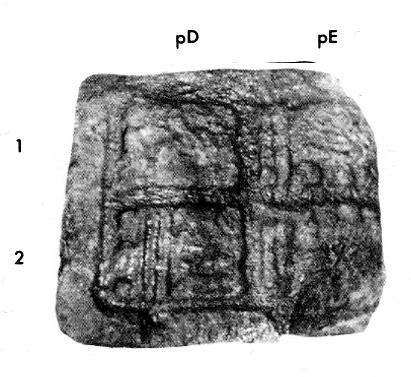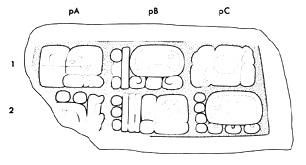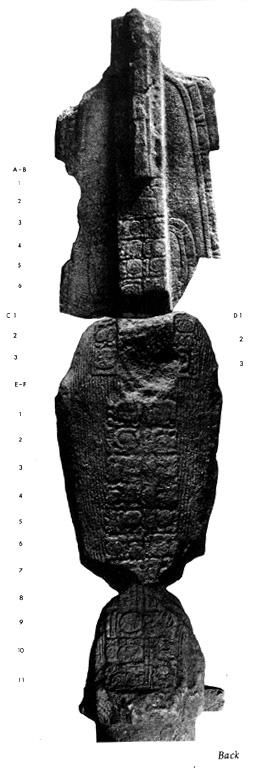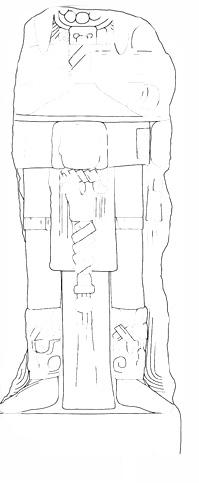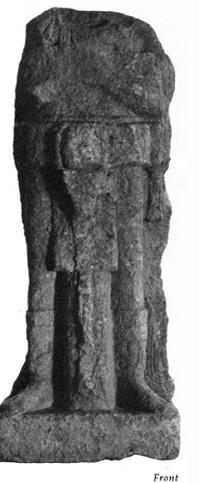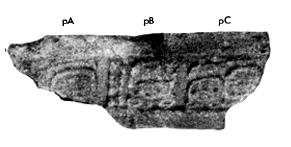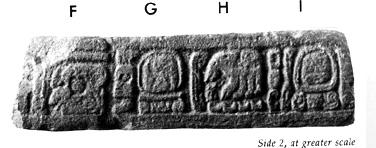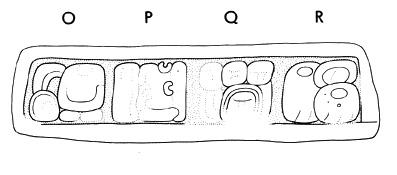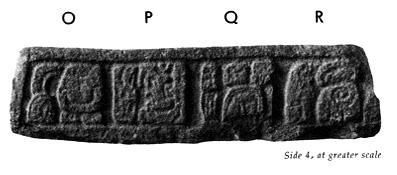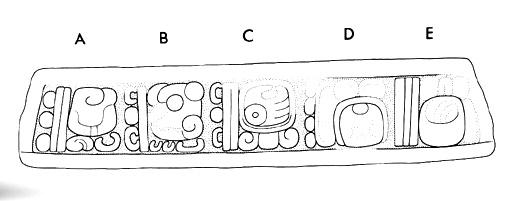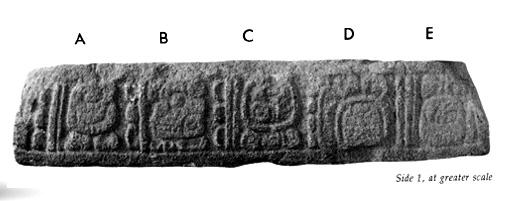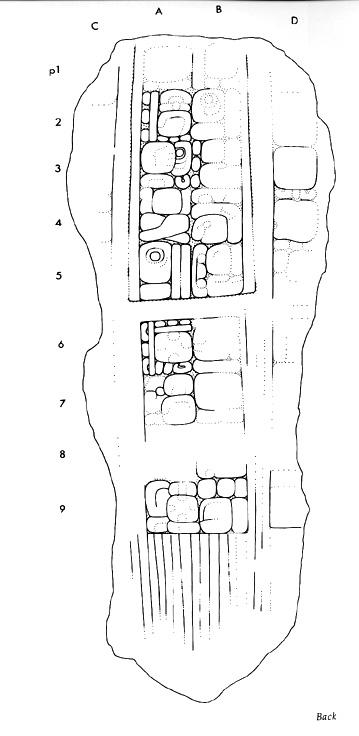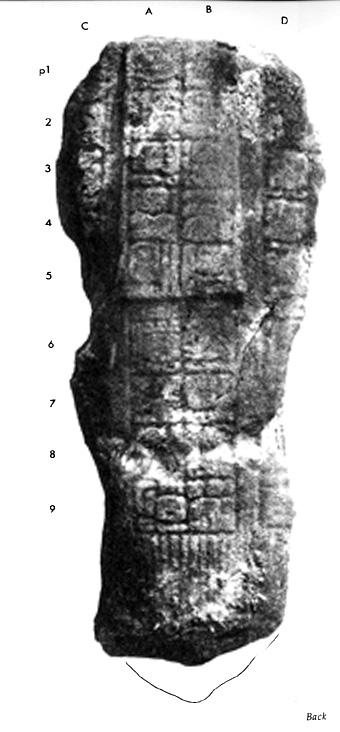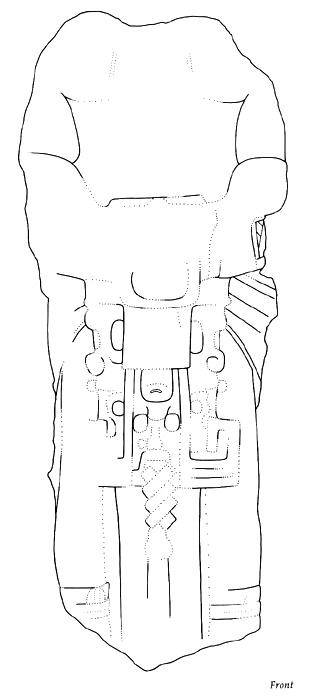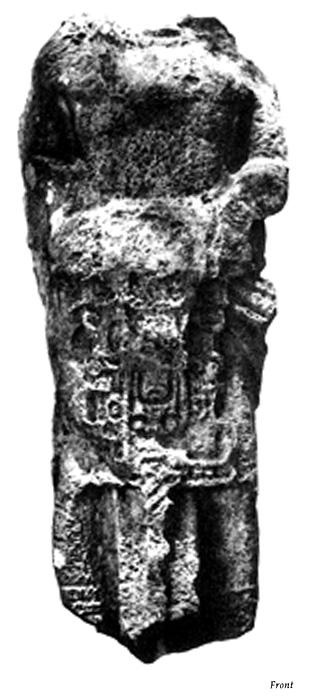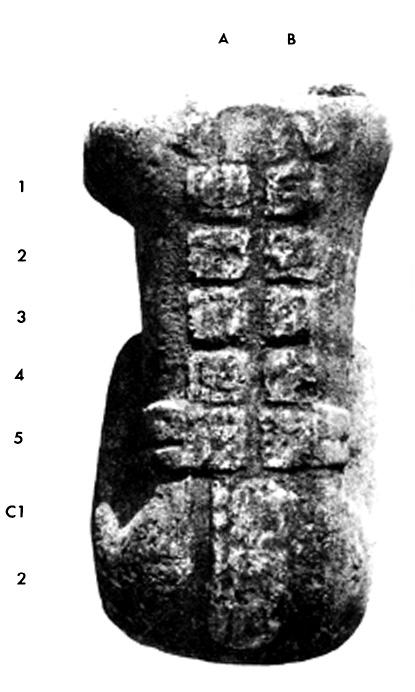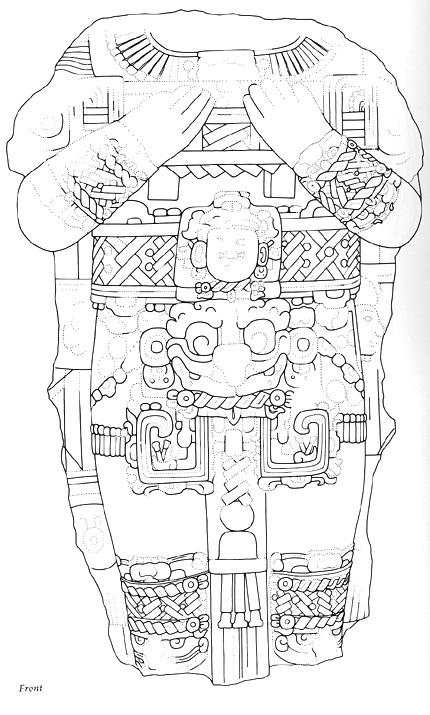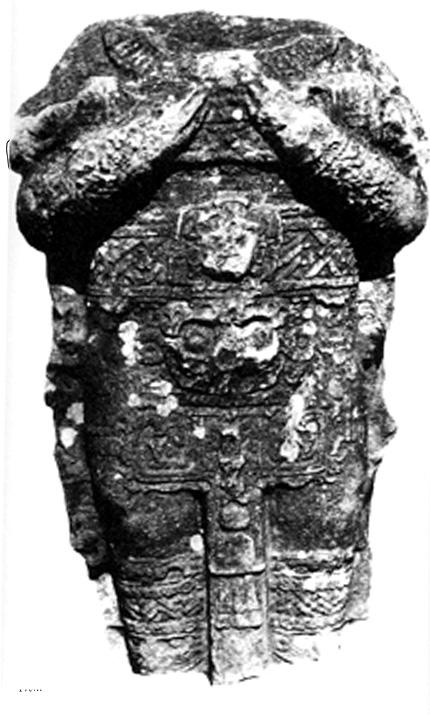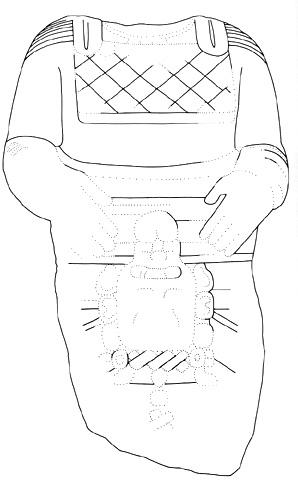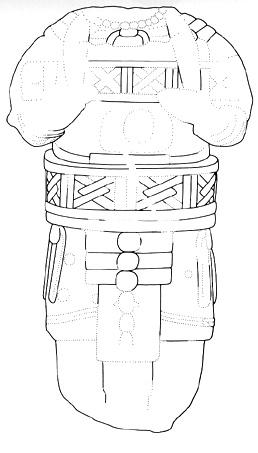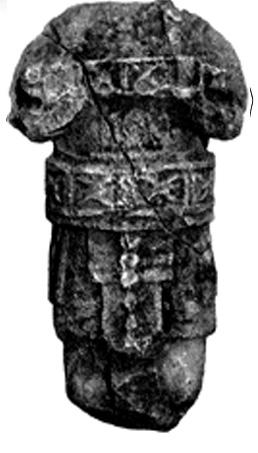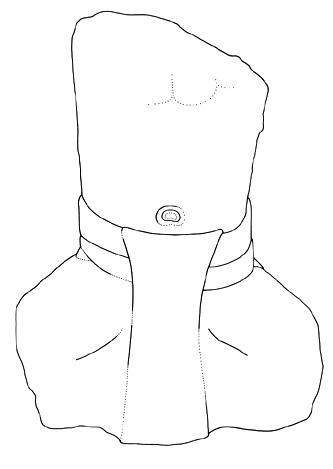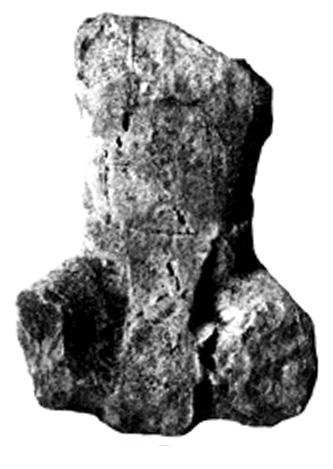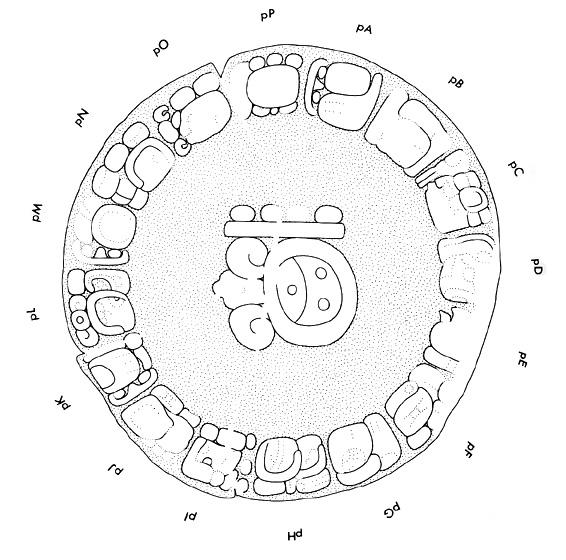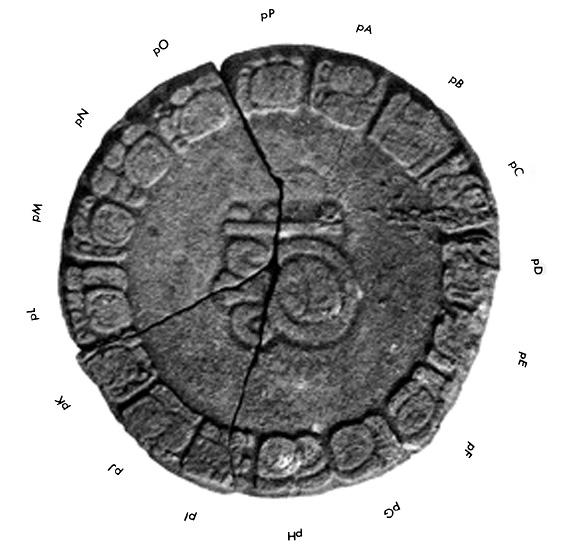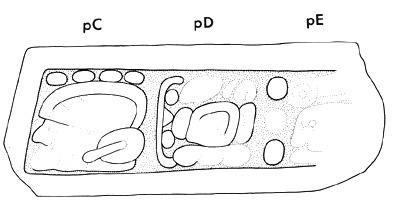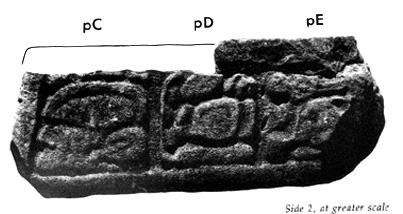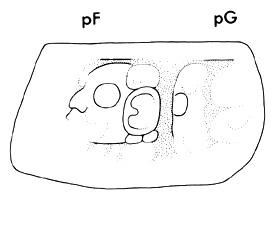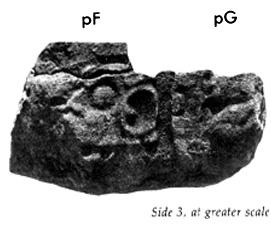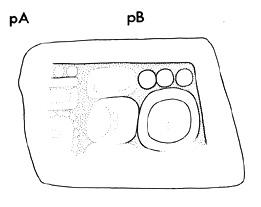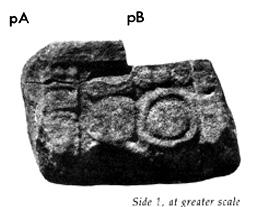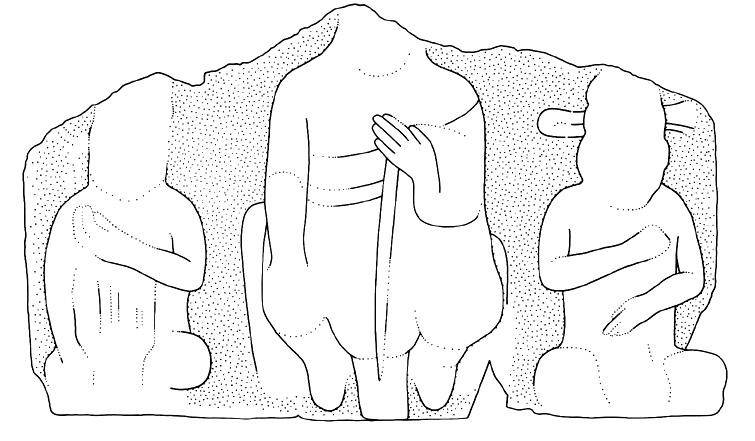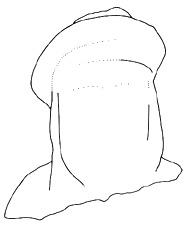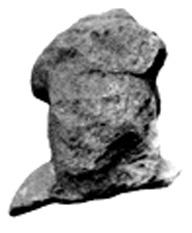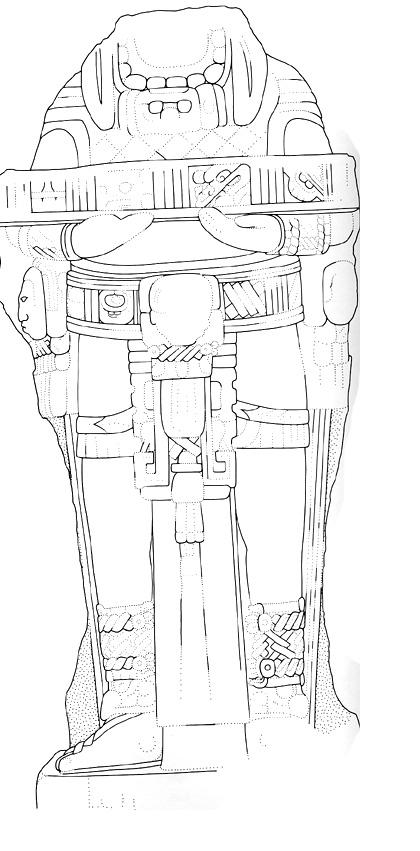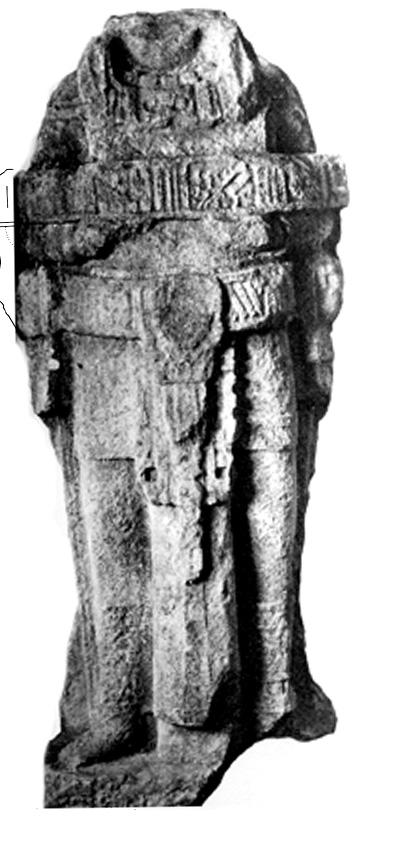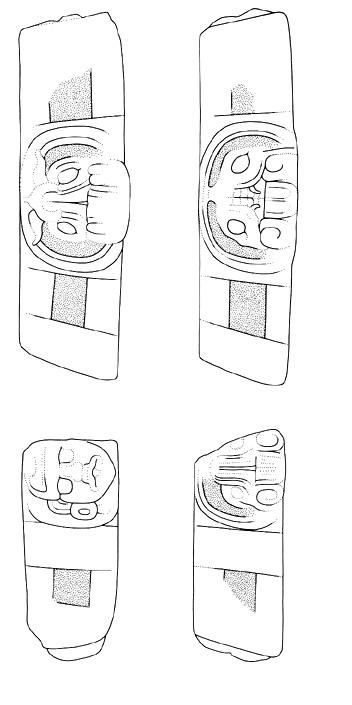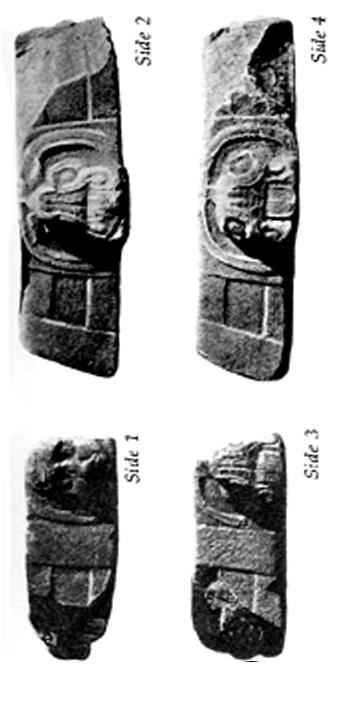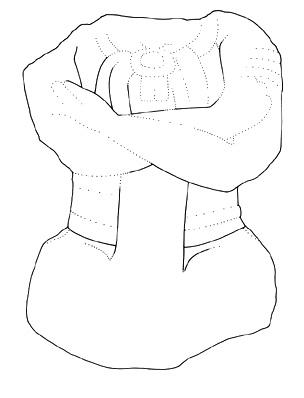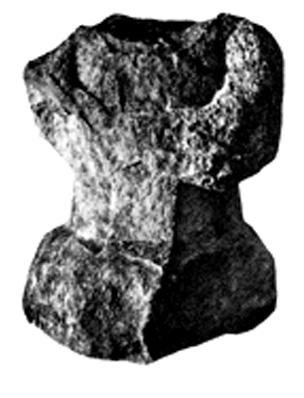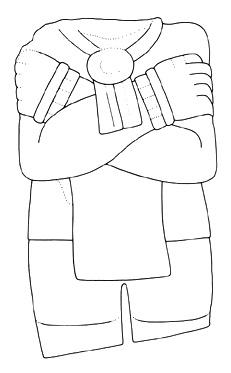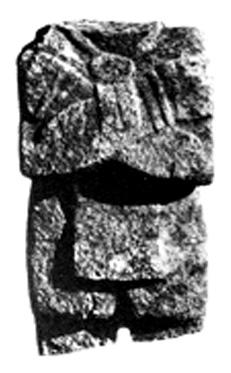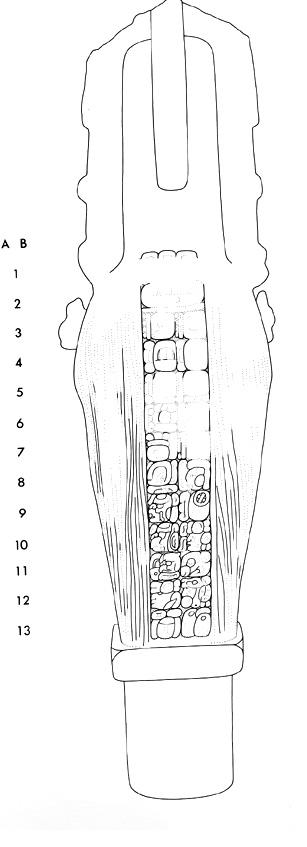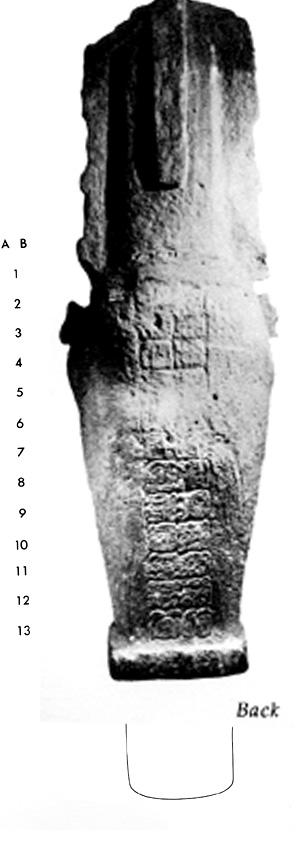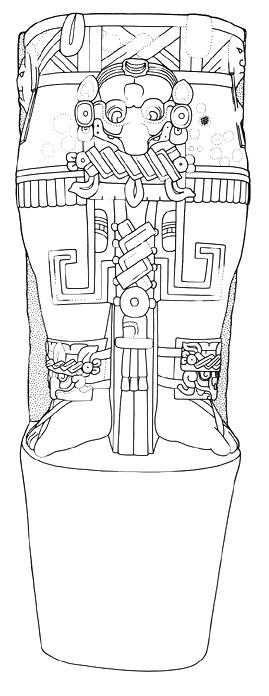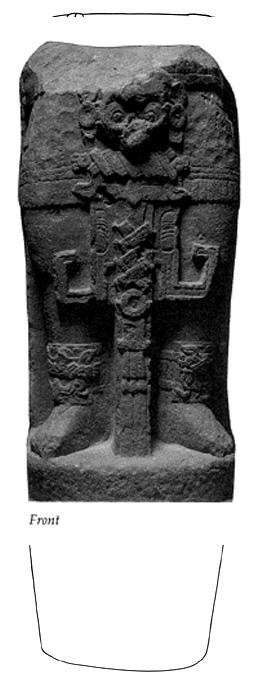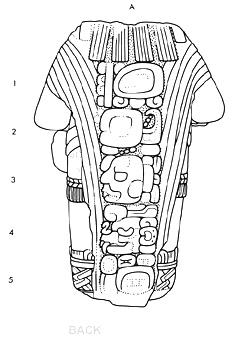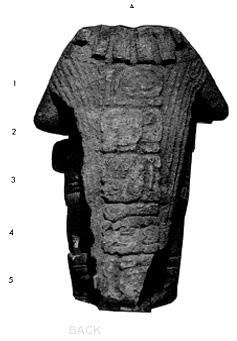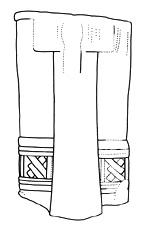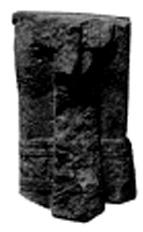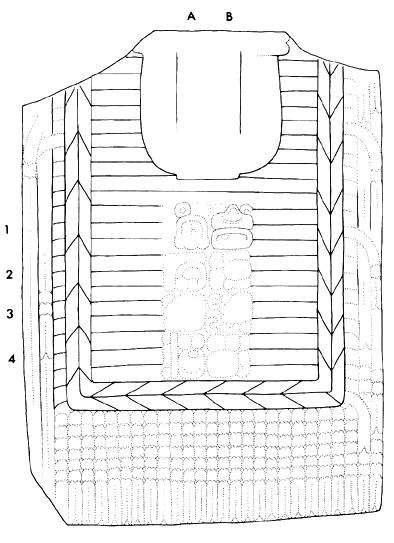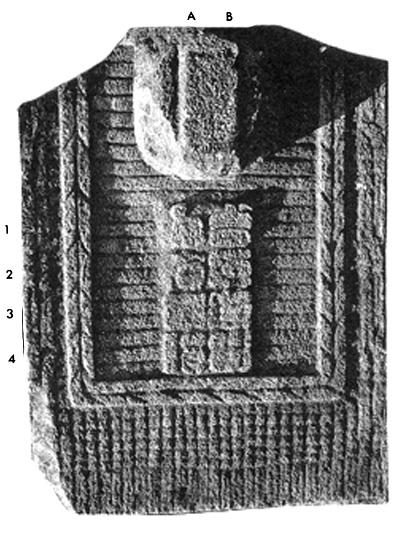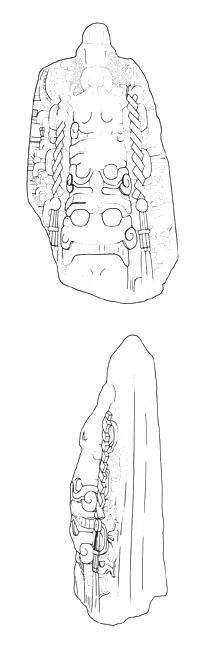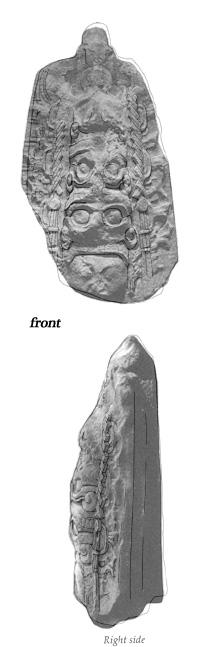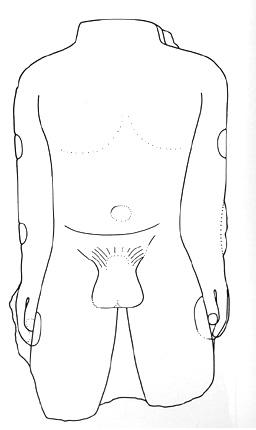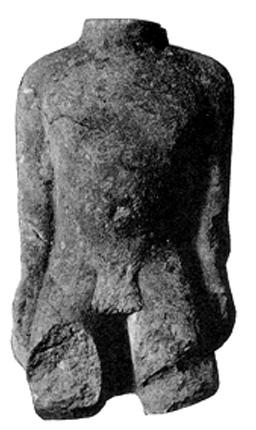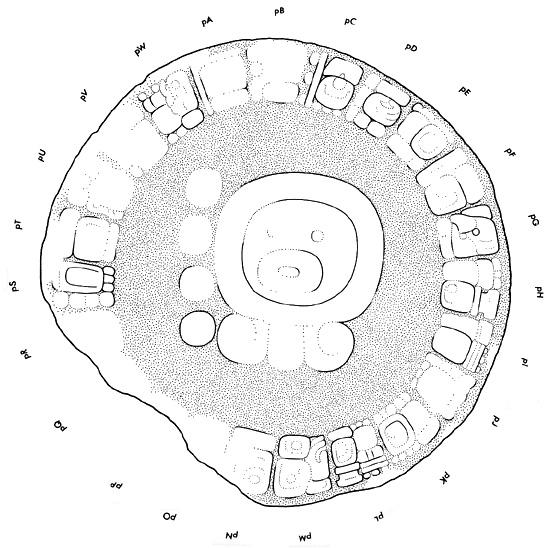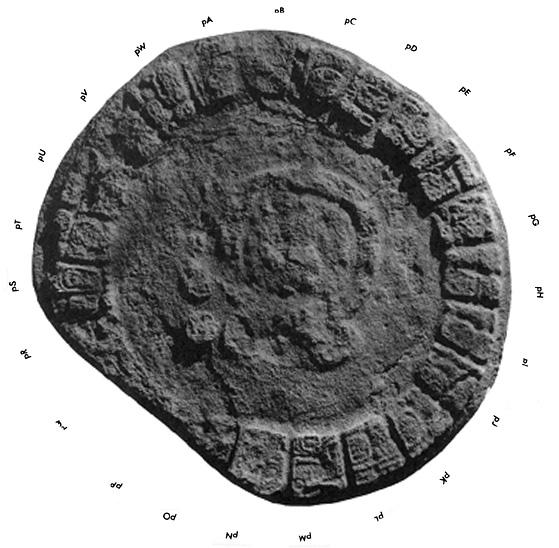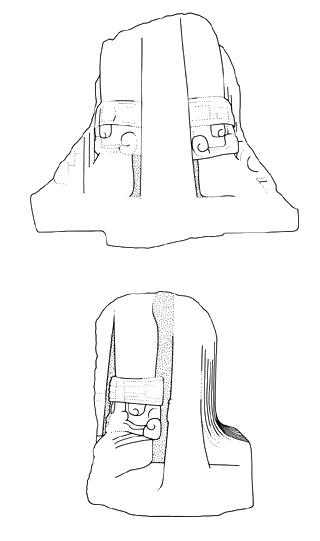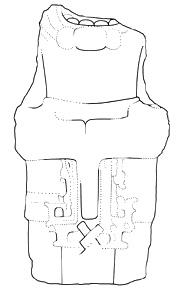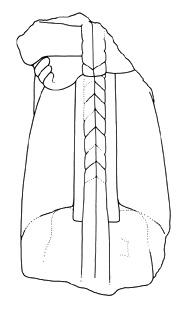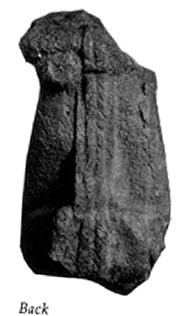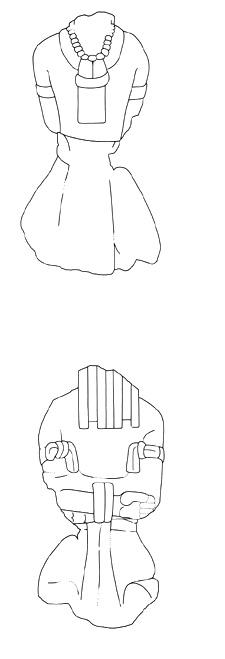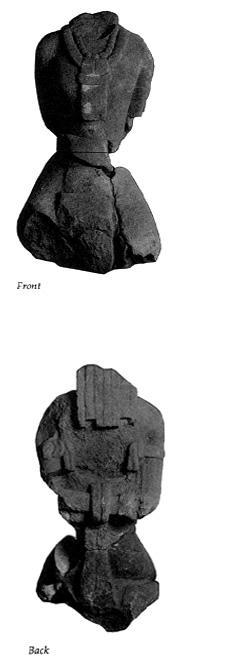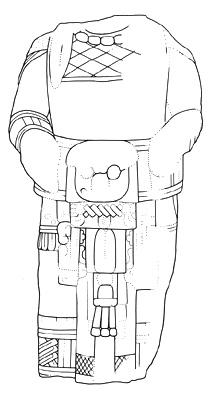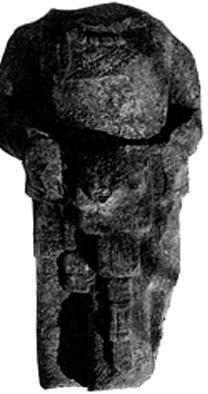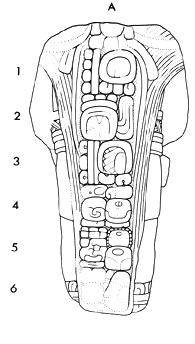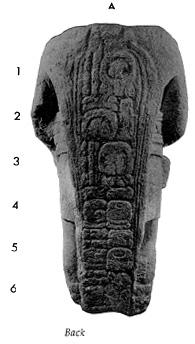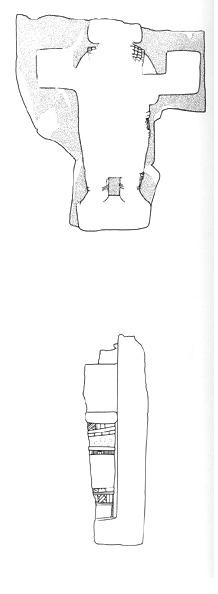Tonina
Other Names for the Site
Aharicab
Tonila
Tulhá
Ocosingo
Location and Access
The ruins are located near the town of Ocosingo, on a range of foothills that forms the northern edge of the Ocosingo Valley. The range of hills is, in fact, one of the many limestone ridges that run roughly northwestsoutheast through the state of Chiapas and into Guatemala. The ridge on which the ruins lie is intersected by small seasonal streams which flow into the Rio de la Virgen or the Rio ]atate, the two rivers that form the Ocosingo Valley.
The main group of ruins is located immediately to the west of one of these seasonal tributaries of the Rio Jatate. The hillside on which the ruins lie was modified by the ancient Maya into a series of terraces rising above a large plaza.
Tonina can be reached quite easily by road from Ocosingo. The journey, some 13 km long, takes about 30 to 40 minutes. From the central square of Ocosingo, one travels southeast on the road running immediately in front of the church. This road (l~ Calle Oriente) is virtually straight until the outskirts of town are reached. At this point, the road swings left shortly before reaching a fork (1.1 km from the square). One follows the left arm of the fork and continues another 1.9 km before reaching a second fork. Again, the left branch should be taken. Four kilometers from the square, the road passes over a bridge spanning the Rio de la Virgen. At 6.2 km and 7.2 km, fords are crossed, and at 8.2 km is another junction and the first signpost to the ruins! The right arm of the fork should be taken here. At 10.2 km is another ford, and at 12.2 km is a ranch which lies at the entrance to the track to the ruins. At this point is another signpost; one turns left off the main road and veers back in the direction of Ocosingo. Almost immediately, one passes over a cattle grid, and at 12.9 km another grid serves as the entrance to the Tonina ranch. At 13.0 km is the ranch. The site museum, which is the official entrance to the ruins, is located to the right of the road. The parking area and new museum lie about 0.4 km farther on, and just beyond them - across the arroyo - are the ruins.
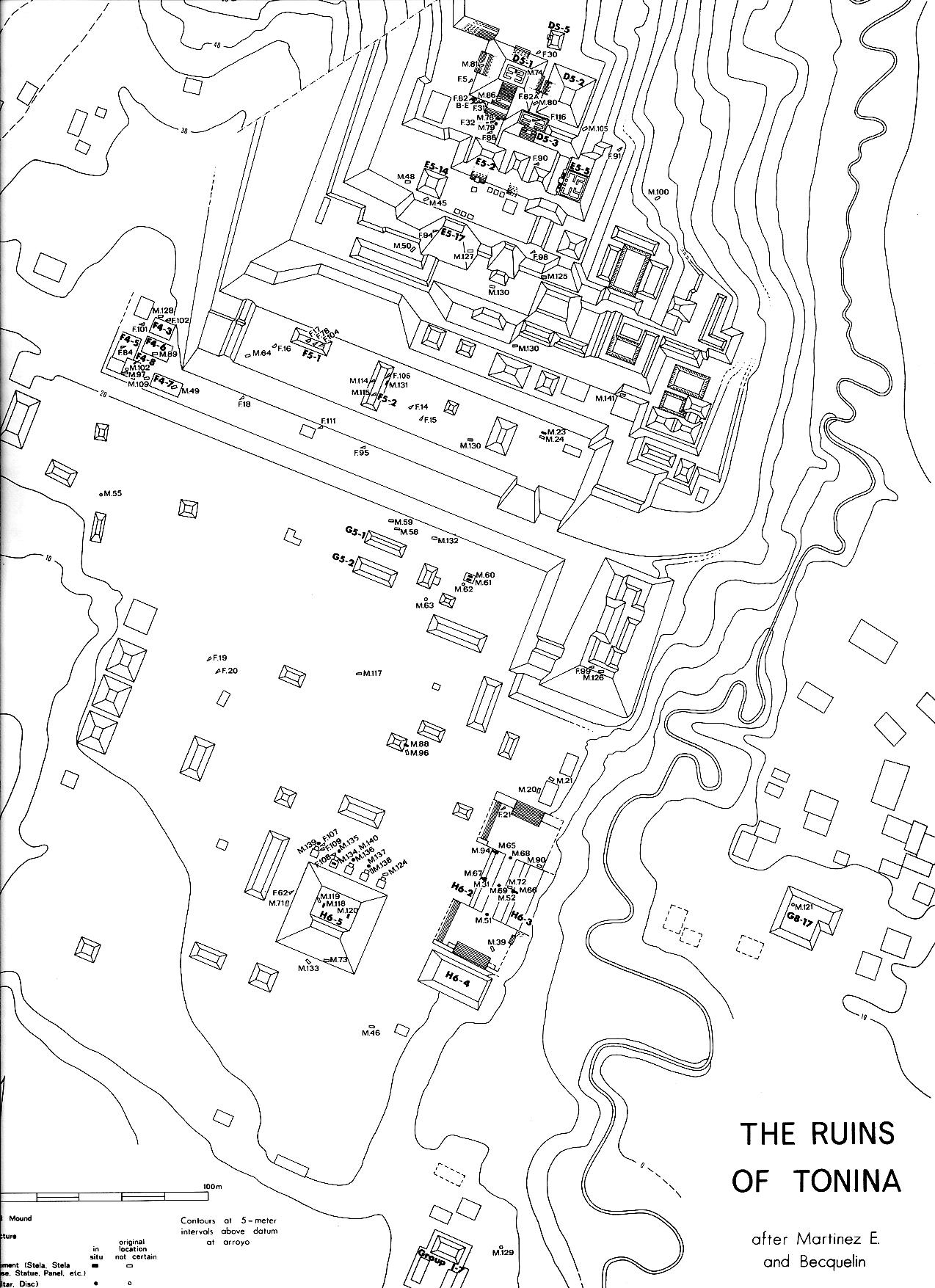
Principal Investigations at the Site
The first mention of Tonina was made by Fray Jacinto Garrido, who lived at the end of the seventeenth century. His description of the site was used as the basis for a passage in the Isagoge Historico Apologetico (anon. 1892, pp. 108-109). The passage is quoted, in translation, by Blom and La Farge (1926-1927, vol. 2, pp. 259-260).
In 1808 Guillaume Dupaix visited Tonina and published a brief description of the site, which is accompanied by illustrations by Antonio Castaneda (1834, vol. 1, Premiere Partie, Troisieme Expedition, pp. 10-13, and vol. 2, Premiere Partie, Troisieme Expedition, pIs. 8-10; Kingsborough 1831-1848, vol. 4, pis. 9-10, vol. 5, pp. 291-294, vol. 6, pp. 470-472; Alcina Franch 1969, pp. 189-194, pIs. 88-91). Four monuments are included among Castaneda's drawings: Monuments 9 and 25 and two other monuments which Dupaix saw in the town hall of Ocosingo but which have not been seen since.
Juarros (1823, p. 19) made brief mention of Tonina under the name Tulha.
John Lloyd Stephens and Frederick Catherwood visited Tonina in 1840 (Stephens 1841, vol. 2, pp. 255-261). Unfortunately, however, only a brief description of two monuments, without illustrations, was published.
E. G. Squier, traveling in the Ocosingo area in 1852, was offered a collection of jades which almost certainly came from Tonina. He bought them and in 1869 donated the collection to the American Museum of Natural History in New York City (Easby 1961).
Other visitors to Tonina during the nineteenth century were Karl Sapper (1895,1896), who made a sketch map of the uppermost temples at the site, and Eduard and Caecilie Seier, who visited the ruins in March 1896. The Selers took photographs, and apparently also made paper molds, of some of the sculptures, including Monuments 7, 9, 22, and 30 (C. Seier 1897, 1900; E. Seier 1901). Meanwhile, other Tonina monuments were finding their way into the National Museum in Mexico City: at present in the Museo Nacional de Antropologia e Historia are Monuments 26, 27, 29, and 47 and a stone disc.
Alfred Tozzer visited Ocosingo and Tonina briefly in 1904; he photographed several sculptures in both locations. His field notes and photographs are now in the collections of the Peabody Museum.
In 1925 Frans Blom and Oliver La Farge visited Tonina. They published a detailed description of the site, including the illustration and description of some 30 monuments (1926-1927, vol. 2, pp. 259-306). Blom returned to the site in 1928 and discovered another monument - the stela from Pestac - and Ball Court 1 (1929, 1935).
Heinrich Berlin visited Tonina briefly in 1942 and discovered several new monuments. A copy of his brief report is in the archive of the Instituto Nacional de Antropologia e Historia in Mexico City. In 1944 S. G. Morley and J. E. S. Thompson spent a few days at the site and ascribed dates to several of the monuments. By this time, some 45 monuments were known. Copies of their field notes are now in the collections of the Peabody Museum.
A further description of Tonina was published by Blom and Duby (1955-1957, vol. 2, pp. 63-88). This included illustrations of two monuments, the lower fragment of Monument 114 and the Lacandon Altar.
In 1972 excavations were begun at Tonina under the joint auspices of the Mission Archeologique et Ethnologique Fran,:;aise au Mexique and the Centre National de la Recherche Scientifique of France (henceforth referred to as the French Tonina Project). These excavations were continued in 1973 and 1974 and again in 1979 and 1980 (Becquelin and Baudez 1971, 1972, 1975, 1979). The directors of the project were Pierre Becquelin and Claude F. Baudez for the 1972-1974 seasons and Pierre Becquelin and Eric Taladoire for the 1979-1980 seasons.
Claude Baudez was in charge of the analysis of the stone monuments from Tonina during the 1972-1974 seasons. Of course, during the excavations many more monuments were found. In addition, numerous pieces lying on the surface were pointed out to the French archaeologists by Antonino Morales Cruz, caretaker of the ruins, and his brother Mario Morales Cruz. Baudez followed the numbering system for the monuments that had been started by Blom, with one emendation: all sculptures, based on their size and completeness, were designated either Monument (M. or Mon.) or Fragment (F. or Frg.). All of the pieces numbered by Blom were given the same monument number by Baudez. By the end of the 1980 excavations, more than 250 monuments and fragments were known from the site.
The results of the French excavations at Tonina are in the process of being published; the first volume (Becquelin and Baudez 1979) has already been published. A second volume, containing among other things descriptions and analyses of the monuments, is scheduled for publication in 1982. This will be followed at a later date by a third volume, covering the excavations of 1979 to 1980.
In 1981 work at Tonina was conducted under the direction of the Mexican archaeologist Juan Yadeun by the Instituto Nacional de Antropologia e Historia. This work will be continued in future seasons.
Work at Tonina by members of the Corpus project has been carried out by Ian Graham during the 1973 field season and by Mathews during the 1980 field season and a short visit to the site in 1981.
Notes on the Ruins
The dominant features of the ruins of Tonina are the artificially modified hillside (on which the majority of the structures were built) and the plaza below it. The plaza, whch measures some 200 by 160 meters, is bounded on the east by Ball Court 1, on the south by the massive pyramidal Structure H6-1, on the west by a series of north-south aligned structures, and on the north by the series of terraces rising above it. Of the structures on these terraces, the most imposing are two large temple structures (D5-1 and D5-2), a lower temple at their southern foot (Structure D5-3, called House B by Blom), and Structure E5-5 (Blom's House A). The last two structures still have vaults surviving.
Smaller mounds and house mounds lie scattered around this central zone, with a major concentration of house mounds lying on the hillside across the arroyo to the east of the main group of ruins. For these and other mounds not shown on the accompanying plan, the map published by the French Tonina Project (Becquelin and Baudez 1979, fig. 5) should be consulted.
Notes on the Plan of the Ruins
The site plan published here is a part of the site plan published by the French Tonina Project (Becquelin and Baudez 1979, fig. 5). The survey work was done for the project by the Mexican surveyor Ing. Eduardo Martinez E. From his excellent contour map of the site, Pierre Becquelin interpreted the structures, and the map was redrawn in Paris. A few minor changes to the 1979 plan have been made, based on the results of more recent excavations at the site.
As noted above, Baudez placed all but a very few of the Tonina sculptures into one of two categories, monument and fragment. The Tonina sculptures can also be dvidied on the basis of whether or not they were found in situ. In fact only a few of the monuments have been found in situ; most of the sculptures have been moved around a great deal, so that for the majority the original provenience has been lost. This is so for several reasons. First, Tonina has been known for a long time, and there have been numerous visitors, both serious and casual, to the site. Many monuments have been moved and even carried off during such visits. Second, the old trail between Ocosingo and the lands to the east passed through the plaza at Tonina, and travelers through the site have no doubt been responsible for some disturbance. Third, previous caretakers of the site have gathered sculptures (on the plaza, for example), without noting their original location. And finally, there is evidence of a Postclassic, but pre-Columbian, disturbance at the site, resulting in the resetting of at least one monument (Mon. 131) and quite probably in the movement (and/or defacement) of others.
All this necessitates some changes in the standard monument symbols in the plans of the mins. Those pieces that were found in situ are designated by solid black symbols; those found archaeologically but not in their original location are shown by open symbols. Sculptures that have been moved or removed in modern times are not included on the plans. The categories of sculpture, monument and fragment, are each subdivided into two groups: (1) discs and altars (designated by a circle) and (2) all other types - stelae, statues, stela bases, panels, etc. (designated by a rectangle). Fragments are designated by only a half of a circle or rectangle to differentiate them from monuments. It is fortunate that no chultuns have been found at Tonina, for it will be noted that the designation for a complete altar or disc not found in situ is the same as the symbol for chultuns in most other Corpus site plans.
Register of Monuments at Tonina
(Volume 6.1) More monuments and fragments continue to be found at Tonina each year, but the present tally (August 1981) is:
Monuments: 1-141
Fragments: 1-32, 34-104, 106-112, 114-115
Pestac Stela
EI Miradero Panel
Lacandon Altar
Disc now in the Museo Nacional de Antropologia e Historia, Mexico City
Stone Box
(Volume 9.2) Monuments and objects that were not included in the register of inscriptions published in Corpus of Maya Hieroglyphic Inscriptions, Volume 6, Part 1, Tonina, have here been assigned numbers as explained in Note 1 below. This list includes:
Monuments 133, 142-176
Miscellaneous 6
Notes
Notes for Volume 6.1
1. No sculptures correspond to Fragment 33, Fragment 105, or Fragment 113.
2. The following monuments and fragments have now been united with others and so will not be dealt with separately:
|
Monument or Fragment |
Will be dealt with under: |
|
Mon. 4 |
Mon. 3 |
|
Mon. 21 |
Mon. 3 |
|
Frg. 12 |
Mon. 83 |
|
Frg. 29 |
Mon. 3 |
|
Frg. 38 |
Mon. 76 |
|
Frg. 39 |
Frg. 1 |
|
Frg. 45 |
Mon. 77 |
|
Frg. 57 |
Mon. 3 |
|
Frg. 71 |
Frg. 8 |
|
Frg. 85 |
Mon. 130 |
|
Frg. 94 |
Frg. 1 |
|
Frg. 96 |
Frg. 8 |
3. The following monuments are plain stelae: Mon. 23, Mon. 60, Mon. 61, Mon. 88, Mon. 96, Mon. 118, Mon. 119, Mon. 120; the following are plain discs: Mon. 51, Mon. 62, Mon. 68, Mon. 79., Mon 103, Mon. 112, Mon. 129, Frg. 22, Frg. 23, Frg. 49, Frg. 51, Frg. 52, Frg. 65, Frg. 70.
4. Two monuments described and illustrated by Dupaix (M.92 and M.93 in the French numeration) have not been reported since the time of his visit. In addition, one monument described in detail in the Isagoge Historico Apologetico (1892, pp. 108-109; see also Blom and Duby 1955-1957, vol. 2, pp. 71-72) has not been located, although it has been numbered M.54 by Baudez. Accordingly, these monuments will not be dealt with in the Corpus.
5. One of the more common types of sculpture at Tonina is the stela base, a low rectangular stone with a hole in its center. It is clear that these sculptures were used as the bases for statues, many of which still have a vertical tenon below their feet. Technically I the shape of a stela base would be described as that of a rectangular frustum, with a cylindrical hole along the central vertical axis. However, since all stela bases (with the exception of Monument 8, to be described separately) have this shape, only "stela base" will be entered under the heading "shape" in the description of each of these monuments.
6. Vertical views of the top of broken stela bases will be presented. These will possibly aid in the uniting of fragments found in the future.
7. Many of the Tonina sculptures represent human figures carved fully in the round. Clearly, two-dimensional line drawings cannot do justice to the three-dimensionality of these sculptures. However, all the details of each sculpture can be seen in three views: front, back, and one side. The right side, as viewed from the front of the statue (the left side of the figure itself), will be illustrated unless the other side is in better condition. In some cases, stereophotos of these three-dimensional statues will also be published.
8. Slightly fewer than half of the 250 or so sculptures from Tonina have inscriptions. Many of those without inscriptions, however, are rich in iconographic detail, and some combine with sculptures containing texts. For these reasons, all Tonina sculptures except for the plain monuments and fragments will be published in the Corpus.
9. Since some of the monuments can be dealt with fairly briefly and since there are so many sculptures from Tonina, the policy of devoting one or more complete leaves of the Corpus to each monument will not be strictly adhered to.
10. Only very poor illustrations of Monument 2 are available (and no photo at all of one of the sides). There are rumors that this stone is still to be found in Ocosingo, but so far I have not been able to see it. I hope that I can photograph the stone and publish it in a later fascicle of the Corpus.
Notes for Volume 9.2
1. In the course of its work at Tonina in the 1980s, the Mission Archéologique et Ethnologique Française au Mexique (MAF) found on the surface, or buried not far beneath it, a large number of sculptures of many different kinds and in various states of fragmentation or erosion. (It should be noted that the terms of their permit did not allow excavation down to the level of Classic period remains.) Nonetheless, much useful archaeological and anthropological information was gathered in a wide surrounding area.
At Tonina itself, the gleanings of sculpture were abundant, and in describing them, the three major authors, Pierre Becquelin, Claude F. Baudez, and Eric Taladoire, catalogued them under two headings: "Monuments" and "Fragments." Their work was published as Tonina, une Cité Maya du Chiapas, Mission Archéologique et Ethnologique Francaise au Mexique, Collection Etudes Mésoaméricaines, vol. 6, part 1 (Mexico DF, 1979), parts 2 and 3 (Paris 1982), and part 4 (Mexico, DF, 1990). References to these volumes in the present work are cited by author, year, and page number.
In these volumes, the numbered monuments run up to 140, and the fragments to 115, with suitable illustration and information concerning provenience.
Their work was soon to be followed up by that of Juan Yadeun, who in the course of twenty-five seasons of excavation was to unearth much fine sculpture. But as none of it has been identified by numeration, the present authors have been obliged to apply their own in random fashion.
2. Users of the Corpus may like to be reminded of the scale at which the photographs are reproduced. Invariably there is one view printed at 1:10 (see CMHI 1:8), and in almost every case, another of the same view and others at greater scale.
3. At the suggestion of Dr. David Stuart, former Bartlett Curator of Maya Hieroglyphic Inscriptions at the Peabody Museum, the term “pedestal” is now recommended for future use in referring to a type of sculpture found only at Tonina, rather than “stela base” as previously employed. For purposes of numeration, pedestals will continue to be subsumed (as stela bases have been) under the broader class of “Monuments.” The term is intended to be no more than descriptive, but in the rare event of a tenoned monument and pedestal forming an undoubted pair (as in the case of Monument 158), then it may be appropriate to name them, as here, Monuments “158f” and “158p” (for “figure” and “pedestal,” respectively) followed by the customary glyph-block designations, as required.
References Cited
ALCINA FRANCH, JOSE
1969 Guillermo Dupaix: expediciones acerca de los antiguos monumentos de Nueva
Espana 1805-1808. 2 vats. JosePorrua Turanza, Madrid.
ANONYMOUS
1892 lsagoge histdrico apologetico general de todas las lndias y especial de la
Provincia de San Vicente Ferrer de Chiapa y Goathemala. Tipografia de Tomas Minuesa de los Rios, Madrid.
BECQUELIN, PIERRE, and CLAUDE F. BAUDEZ
1971 "Recherches archeologiques it Tonina, Chiapas, Mexique," Journal de la
Societe des Americanistes, voL 60, pp. 302-304. Paris.
1972 "Recherches archeologiques it Tonina, Chiapas, Mexique: La seconde
saison de fouilles (1973)," Journal de la Societe des Americanistes, voL 61, pp. 255-257. Paris.
1975 "Tonina, une cite Maya de l'age classique," Archeologia, no. 80, pp.
10-22. Paris.
1979 Tonina, une cite Maya du Chiapas (Mexique). Mission Archeologique et
Ethnologique Frano;aise au Mexique, Etudes Mesoamericaines, voL 6, part 1. Mexico City.
BLOM, FRANS
1929 Preliminary Report of the John Geddings Gray Memorial Expedition.
Department of Middle American Research, Tulane University. New Orleans.
1935 "The Pesctac [sic] Stela," Maya Research, vol. 2, no. 2, pp. 190-191,193.
New York.
8LOM, FRANS, and GERTRUDE DUBY
1955--1957 La Selva Lacandona. 2 vols. Editorial Cultura, Mexico City.
8LOM, FRANS, and OLIVER LA FARGE
1926-1927 Tribes and Temples. 2 vols. Tulane University, New Orleans.
DUPAIX, GUILLAUME
1834 AntiquiUs Mexicaines: relation des trois expeditions du Capitaine Dupaix,
ordonnes en 1805, 1806, et 1807 pour la recherche des antiquites du pays, notamment celles de Mitla et de Palenque; accompagnee des dessins de Castaneda. 2 vols. Paris.
EASBY, ELIZABETH K.
1961 "The Squier Jades from Tonina, Chiapas," in Essays in Pre-Columbian Art
and Archaeology, by Samuel K. Lothrop et al., pp. 60-80. Cambridge, Massachusetts.
GALINDO Y VILLA, JESUS
1901 Catdlogo del Departamento de Arqueologia del Museo Nacional. Primera
parte: Galeria de Monolitos. Imprenta del Museo National, Mexico City.
1902 Album de antigiiedades indigenas que se conseroan en el Museo Nacional de
Mexico. Imprenta del Museo Nacional, Mexico City. jUARROS, DOMINGO
1823 A Statistical and Commercial Hisfory of the Kingdom of Guatemala, in
Spanish America, trans. by J. Baily. London.
KINGSBOROUGH, E. K.
1831-1848 Antiquities of Mexico. 9 vols. London.
PASO Y TRONCOSO, FRANOSCO
1892-1893 Catdlogo de la Seccion de Mexico: Exposicion Historico-Americana de
Madrid. 2 vols. Est. Tip. "Sucesores de Rivadeneyra," Madrid.
PENAFIEL, ANTONIO
1903 Indumentaria antigua: vestidos guerreros y civiles de los Mexicanos. Ofidna
Tip. de la Secretaria de Fomento, Mexico City.
SAPPER, KARL
1895 "Altindianische Siedelungen und Bauten im nordlichen Mittelamerika,"
Globus, vol. 68, no. 11, pp. 165-169, and no. 12, pp. 183-189. Braunschweig.
1896 "The Old Indian Settlements and Architectural Structures in Northern
Central America," Annual Report of the Board of Regents of the Smithsonian Institution (1895), pp. 537-555. Washington, D.C. (English translation of Sapper 1895).
SELER, CAECILIE
1897 "Kurzer Bericht tiber eine archaologische Reise durch Mexiko und
Mittelamerika," Globus, vol. 72, no. 6, pp. 85-87. Braunschweig.
1900 Auf alten Wegen in Mexiko und Guatemala. Dietrich Reimer, Berlin.
SELER, EDUARD
1901 Die alten Ansiedelungen von Chaculd im Distrikte Nenton des Departements
Huehuetenango der Republik Guatemala. Reimer, Berlin.
STEPHENS, JOHN L.
1841 Incidents of Travel in Central America, Chiapas and Yucatan. 2 vols. Harper
and Bros . New York
Site Volume Reference
| SITE | VOL/Part | Monument | Side | Page | Pub.year | Notes | Peabody Number |
| TONINA | 6.1 | Map | 5 | 1983 | |||
| TONINA | 6.1 | Map of Ruins | 6 | 1983 | |||
| TONINA | 6.1 | Monument 1 | side p1 | 14 | 1983 | 2004.15.6.14.1 | |
| TONINA | 6.1 | Monument 1 | side p2 | 14 | 1983 | additional copy exists | 2004.15.6.14.2 |
| TONINA | 6.1 | Monument 3 | front | 16 | 1983 | 2004.15.6.14.3 | |
| TONINA | 6.1 | Monument 3 | right side | 17 | 1983 | 2004.15.6.14.4 | |
| TONINA | 6.1 | Monument 3 | back | 18 | 1983 | 2004.15.6.14.5 | |
| TONINA | 6.1 | Monument 5 | front | 21 | 1983 | 2004.15.6.14.6 | |
| TONINA | 6.1 | Monument 5 | right side | 21 | 1983 | 2004.15.6.14.7 | |
| TONINA | 6.1 | Monument 5 | back | 22 | 1983 | 2004.15.6.14.8 | |
| TONINA | 6.1 | Monument 6 | side | 23 | 1983 | 2004.15.6.14.9 | |
| TONINA | 6.1 | Monument 7 | side 1 | 25 | 1983 | all one piece | 2004.15.6.14.10 |
| TONINA | 6.1 | Monument 7 | side 2 | 25 | 1983 | ||
| TONINA | 6.1 | Monument 7 | 26 | 1983 | |||
| TONINA | 6.1 | Monument 7 | 26 | 1983 | |||
| TONINA | 6.1 | Monument 8 | side 1 | 28 | 1983 | 2004.15.6.14.11 | |
| TONINA | 6.1 | Monument 8 | side 2 | 29 | 1983 | 2004.15.6.14.12 | |
| TONINA | 6.1 | Monument 8 | side 3 | 30 | 1983 | 2004.15.6.14.13 | |
| TONINA | 6.1 | Monument 8 | side 4 | 31 | 1983 | 2004.15.6.14.14 | |
| TONINA | 6.1 | Monument 9 | front | 33 | 1983 | 2004.15.6.14.15 | |
| TONINA | 6.1 | Monument 9 | right side | 33 | 1983 | 2004.15.6.14.16 | |
| TONINA | 6.1 | Monument 9 | back | 34 | 1983 | 2004.15.6.14.17 | |
| TONINA | 6.1 | Monument 10 | front | 35 | 1983 | 2004.15.6.14.18 | |
| TONINA | 6.1 | Monument 10 | right side | 35 | 1983 | 2004.15.6.14.19 | |
| TONINA | 6.1 | Monument 10 | top | 36 | 1983 | 2004.15.6.14.20 | |
| TONINA | 6.1 | Monument 11 | side | 37 | 1983 | 2004.15.6.14.21 | |
| TONINA | 6.1 | Monument 12 | front | 39 | 1983 | 2004.15.6.14.22 | |
| TONINA | 6.1 | Monument 12 | right side | 40 | 1983 | 2004.15.6.14.23 | |
| TONINA | 6.1 | Monument 12 | back | 41 | 1983 | 2004.15.6.14.24 | |
| TONINA | 6.1 | Monument 13 | front | 42 | 1983 | 2004.15.6.14.25 | |
| TONINA | 6.1 | Monument 13 | right side | 43 | 1983 | 2004.15.6.14.26 | |
| TONINA | 6.1 | Monument 13 | back | 43 | 1983 | 2004.15.6.14.27 | |
| TONINA | 6.1 | Monument 14 | front | 44 | 1983 | 2004.15.6.14.28 | |
| TONINA | 6.1 | Monument 14 | right side | 45 | 1983 | 2004.15.6.14.29 | |
| TONINA | 6.1 | Monument 14 | back | 45 | 1983 | 2004.15.6.14.30 | |
| TONINA | 6.1 | Monument 15 | front | 46 | 1983 | 2004.15.6.14.31 | |
| TONINA | 6.1 | Monument 15 | right side | 47 | 1983 | 2004.15.6.14.32 | |
| TONINA | 6.1 | Monument 15 | back | 47 | 1983 | 2004.15.6.14.33 | |
| TONINA | 6.1 | Monument 16 | top | 48 | 1983 | 2004.15.6.14.34 | |
| TONINA | 6.1 | Monument 17 | side 1 | 49 | 1983 | all one piece | 2004.15.6.14.35 |
| TONINA | 6.1 | Monument 17 | side 2 | 50 | 1983 | ||
| TONINA | 6.1 | Monument 17 | side 3 | 50 | 1983 | ||
| TONINA | 6.1 | Monument 18 | front | 51 | 1983 | 2004.15.6.14.36 | |
| TONINA | 6.1 | Monument 19 | front | 52 | 1983 | 2004.15.6.14.37 | |
| TONINA | 6.1 | Monument 19 | left side | 52 | 1983 | 2004.15.6.14.38 | |
| TONINA | 6.1 | Monument 19 | back | 52 | 1983 | 2004.15.6.14.39 | |
| TONINA | 6.1 | Monument 20 | front | 54 | 1983 | 2004.15.6.14.40 | |
| TONINA | 6.1 | Monument 20 | right side | 55 | 1983 | 2004.15.6.14.41 | |
| TONINA | 6.1 | Monument 20 | back | 56 | 1983 | 2004.15.6.14.42 | |
| TONINA | 6.1 | Monument 22 | side 1 | 57 | 1983 | 2004.15.6.14.43 | |
| TONINA | 6.1 | Monument 22 | side 2 | 57 | 1983 | 2004.15.6.14.44 | |
| TONINA | 6.1 | Monument 22 | side 3 | 57 | 1983 | 2004.15.6.14.45 | |
| TONINA | 6.1 | Monument 22 | side 4 | 57 | 1983 | 2004.15.6.14.46 | |
| TONINA | 6.1 | Monument 24 | front | 58 | 1983 | 2004.15.6.14.47 | |
| TONINA | 6.1 | Monument 24 | right side | 59 | 1983 | 2004.15.6.14.48 | |
| TONINA | 6.1 | Monument 24 | back | 59 | 1983 | 2004.15.6.14.49 | |
| TONINA | 6.1 | Monument 25 | front | 60 | 1983 | 2004.15.6.14.50 | |
| TONINA | 6.1 | Monument 25 | right side | 60 | 1983 | 2004.15.6.14.51 | |
| TONINA | 6.1 | Monument 26 | front | 61 | 1983 | 2004.15.6.14.52 | |
| TONINA | 6.1 | Monument 26 | right side | 62 | 1983 | 2004.15.6.14.53 | |
| TONINA | 6.1 | Monument 26 | back | 63 | 1983 | 2004.15.6.14.54 | |
| TONINA | 6.2 | Monument 27 | front | 71 | 1996 | 2004.15.6.15.1 | |
| TONINA | 6.2 | Monument 28 | front | 72 | 1996 | 2004.15.6.15.2 | |
| TONINA | 6.2 | Monument 28 | back | 73 | 1996 | 2004.15.6.15.3 | |
| TONINA | 6.2 | Monument 28 | right side | 74 | 1996 | 2004.15.6.15.4 | |
| TONINA | 6.2 | Monument 29 | front | 75 | 1996 | additional copy exists | 2004.15.6.15.5 |
| TONINA | 6.2 | Monument 29 | back | 75 | 1996 | additional copy exists | 2004.15.6.15.6 |
| TONINA | 6.2 | Monument 29 | left side | 75 | 1996 | 2004.15.6.15.7 | |
| TONINA | 6.2 | Monument 30 | front | 76 | 1996 | 2004.15.6.15.8 | |
| TONINA | 6.2 | Monument 30 | left side | 76 | 1996 | 2004.15.6.15.9 | |
| TONINA | 6.2 | Monument 30 | back | 77 | 1996 | 2004.15.6.15.10 | |
| TONINA | 6.2 | Monument 31 | front | 78 | 1996 | 2004.15.6.15.11 | |
| TONINA | 6.2 | Monument 32 | front | 79 | 1996 | 2004.15.6.15.12 | |
| TONINA | 6.2 | Monument 32 | right side | 79 | 1996 | 2004.15.6.15.13 | |
| TONINA | 6.2 | Monument 32 | back | 79 | 1996 | 2004.15.6.15.14 | |
| TONINA | 6.2 | Monument 33 | front | 80 | 1996 | 2004.15.6.15.15 | |
| TONINA | 6.2 | Monument 33 | right side | 80 | 1996 | 2004.15.6.15.16 | |
| TONINA | 6.2 | Monument 34 | circular disk | 81 | 1996 | 2004.15.6.15.17 | |
| TONINA | 6.2 | Monument 35 | front | 82 | 1996 | 2004.15.6.15.18 | |
| TONINA | 6.2 | Monument 35 | right side | 82 | 1996 | 2004.15.6.15.19 | |
| TONINA | 6.2 | Monument 35 | back | 82 | 1996 | 2004.15.6.15.20 | |
| TONINA | 6.2 | Monument 36 | front | 83 | 1996 | 2004.15.6.15.21 | |
| TONINA | 6.2 | Monument 36 | right side | 83 | 1996 | additional copy exists | 2004.15.6.15.22 |
| TONINA | 6.2 | Monument 36 | back | 83 | 1996 | 2004.15.6.15.23 | |
| TONINA | 6.2 | Monument 37 | front | 84 | 1996 | 2004.15.6.15.24 | |
| TONINA | 6.2 | Monument 37 | back | 84 | 1996 | 2004.15.6.15.25 | |
| TONINA | 6.2 | Monument 37 | right side | 84 | 1996 | 2004.15.6.15.26 | |
| TONINA | 6.2 | Monument 38 | back | 85 | 1996 | 2004.15.6.15.27 | |
| TONINA | 6.2 | Monument 38 | back | 85 | 1996 | 2004.15.6.15.28 | |
| TONINA | 6.2 | Monument 39 | front | 86 | 1996 | 2004.15.6.15.29 | |
| TONINA | 6.2 | Monument 39 | right side | 86 | 1996 | 2004.15.6.15.30 | |
| TONINA | 6.2 | Monument 39 | back | 86 | 1996 | 2004.15.6.15.31 | |
| TONINA | 6.2 | Monument 39 | section of ball court | 87 | 1996 | map | |
| TONINA | 6.2 | Monument 40 | front | 88 | 1996 | 2004.15.6.15.32 | |
| TONINA | 6.2 | Monument 40 | right side | 88 | 1996 | 2004.15.6.15.33 | |
| TONINA | 6.2 | Monument 40 | back | 88 | 1996 | 2004.15.6.15.34 | |
| TONINA | 6.2 | Monument 41 | front | 89 | 1996 | 2004.15.6.15.35 | |
| TONINA | 6.2 | Monument 41 | back | 89 | 1996 | 2004.15.6.15.36 | |
| TONINA | 6.2 | Monument 41 | left side | 89 | 1996 | 2004.15.6.15.37 | |
| TONINA | 6.2 | Monument 42 | sides | 90 | 1996 | 2004.15.6.15.38 | |
| TONINA | 6.2 | Monument 43 | sides | 91 | 1996 | 2 pieces | 2004.15.6.15.39;40 |
| TONINA | 6.2 | Monument 44 | sides | 92 | 1996 | 2004.15.6.15.41 | |
| TONINA | 6.2 | Monument 45 | front | 93 | 1996 | 2004.15.6.15.42 | |
| TONINA | 6.2 | Monument 45 | left side | 93 | 1996 | 2004.15.6.15.43 | |
| TONINA | 6.2 | Monument 45 | back | 93 | 1996 | 2004.15.6.15.44 | |
| TONINA | 6.2 | Monument 46 | front | 94 | 1996 | 2004.15.6.15.45 | |
| TONINA | 6.2 | Monument 46 | right side | 94 | 1996 | 2004.15.6.15.46 | |
| TONINA | 6.2 | Monument 46 | back | 94 | 1996 | 2004.15.6.15.47 | |
| TONINA | 6.2 | Monument 47 | front | 95 | 1996 | 2004.15.6.15.48 | |
| TONINA | 6.2 | Monument 47 | right side | 95 | 1996 | 2004.15.6.15.49 | |
| TONINA | 6.2 | Monument 47 | back | 95 | 1996 | 2004.15.6.15.50 | |
| TONINA | 6.2 | Monument 50 | front | 96 | 1996 | 2004.15.6.15.51 | |
| TONINA | 6.2 | Monument 50 | right side | 96 | 1996 | 2004.15.6.15.52 | |
| TONINA | 6.2 | Monument 52 | front | 97 | 1996 | 2004.15.6.15.53 | |
| TONINA | 6.2 | Monument 55 | cylindrical | 98 | 1996 | 2004.15.6.15.54 | |
| TONINA | 6.2 | Monument 56 | front | 99 | 1996 | 2004.15.6.15.55 | |
| TONINA | 6.2 | Monument 56 | right side | 99 | 1996 | 2004.15.6.15.56 | |
| TONINA | 6.2 | Monument 56 | back | 100 | 1996 | 2004.15.6.15.57 | |
| TONINA | 6.2 | Monument 63 | part of circular disc | 101 | 1996 | 2004.15.6.15.58 | |
| TONINA | 6.2 | Monument 65 | front | 102 | 1996 | 2004.15.6.15.59 | |
| TONINA | 6.2 | Monument 69 | disc | 103 | 1996 | 2004.15.6.15.60 | |
| TONINA | 6.2 | Monument 70 | front | 104 | 1996 | one piece | 2004.15.6.15.61 |
| TONINA | 6.2 | Monument 70 | right side | 104 | 1996 | ||
| TONINA | 6.2 | Monument 70 | back | 104 | 1996 | ||
| TONINA | 6.2 | Monument 71 | front | 105 | 1996 | 2004.15.6.15.62 | |
| TONINA | 6.2 | Monument 71 | back | 105 | 1996 | missing photo | 2004.15.6.15.63 |
| TONINA | 6.2 | Monument 71 | left side | 105 | 1996 | 2004.15.6.15.64 | |
| TONINA | 6.2 | Monument 72 | front | 106 | 1996 | 2004.15.6.15.65 | |
| TONINA | 6.2 | Monument 74 | left side | 107 | 1996 | one piece | 2004.15.6.15.66 |
| TONINA | 6.2 | Monument 74 | front | 107 | 1996 | ||
| TONINA | 6.2 | Monument 75 | disc | 108 | 1996 | 2004.15.6.15.67 | |
| TONINA | 6.2 | Monument 76 | disc | 108 | 1996 | additional copy exists | 2004.15.6.15.68 |
| TONINA | 6.2 | Monument 77 | side | 110 | 1996 | 2004.15.6.15.69 | |
| TONINA | 6.2 | Monument 80 | front | 111 | 1996 | 2004.15.6.15.70 | |
| TONINA | 6.2 | Monument 80 | back | 111 | 1996 | 2004.15.6.15.71 | |
| TONINA | 6.2 | Monument 80 | left side | 111 | 1996 | 2004.15.6.15.72 | |
| TONINA | 6.2 | Monument 82 | disc | 112 | 1996 | 2004.15.6.15.73 | |
| TONINA | 6.2 | Monument 83 | wall Panel; | 113 | 1996 | additional enlarged copy | 2004.15.6.15.74;75 |
| TONINA | 6.2 | Monument 84 | front | 114 | 1996 | 2004.15.6.15.76 | |
| TONINA | 6.2 | Monument 85 | front | 115 | 1996 | 2004.15.6.15.77 | |
| TONINA | 6.2 | Monument 85 | right side | 115 | 1996 | 2004.15.6.15.78 | |
| TONINA | 6.2 | Monument 85 | back | 116 | 1996 | 2004.15.6.15.79 | |
| TONINA | 6.2 | Monument 87 | front | 117 | 1996 | 2004.15.6.15.80 | |
| TONINA | 6.2 | Monument 87 | right side | 117 | 1996 | 2004.15.6.15.81 | |
| TONINA | 6.2 | Monument 87 | back | 117 | 1996 | 2004.15.6.15.82 | |
| TONINA | 6.2 | Monument 89 | top | 118 | 1996 | 2004.15.6.15.83 | |
| TONINA | 6.2 | Monument 89 | side | 118 | 1996 | 2004.15.6.15.84 | |
| TONINA | 6.2 | Monument 91 | sides | 119 | 1996 | 2004.15.6.15.85 | |
| TONINA | 6.2 | Monument 95 | four sides | 120 | 1996 | 2 pieces | 2004.15.6.15.86;87 |
| TONINA | 6.2 | Monument 99 | front rectangular panel | 122 | 1996 | additional copy exists | 2004.15.6.15.88 |
| TONINA | 6.2 | Monument 100 | front | 123 | 1996 | additional copy exists | 2004.15.6.15.89 |
| TONINA | 6.2 | Monument 100 | back | 123 | 1996 | 2004.15.6.15.90 | |
| TONINA | 6.2 | Monument 100 | left side | 123 | 1996 | 2004.15.6.15.91 | |
| TONINA | 6.2 | Monument 101 | front | 124 | 1996 | 2004.15.6.15.92 | |
| TONINA | 6.2 | Monument 101 | right side | 124 | 1996 | 2004.15.6.15.93 | |
| TONINA | 6.2 | Monument 101 | back | 125 | 1996 | 2004.15.6.15.94 | |
| TONINA | 6.2 | Monument 102 | front | 126 | 1996 | 2004.15.6.15.95 | |
| TONINA | 6.2 | Monument 102 | back | 126 | 1996 | 2004.15.6.15.96 | |
| TONINA | 6.2 | Monument 102 | left side | 126 | 1996 | 2004.15.6.15.97 | |
| TONINA | 6.2 | Monument 104 | four sides | 127 | 1996 | 2004.15.6.15.98 | |
| TONINA | 6.3 | Monument 106 | Panel pB,pC-1,2,3 | 135 | 1999 | one piece | 2004.15.6.16.1 |
| TONINA | 6.3 | Monument 106 | Panel A, p1-p2 | 135 | 1999 | ||
| TONINA | 6.3 | Monument 107 | Panel A-D, lg scale | 137 | 1999 | 2004.15.6.16.2 | |
| TONINA | 6.3 | Monument 108 | figure A,1-3, lg scale | 138 | 1999 | 2004.15.6.16.3 | |
| TONINA | 6.3 | Monument 108 | left side | 139 | 1999 | 2004.15.6.16.4 | |
| TONINA | 6.3 | Monument 108 | back | 139 | 1999 | 2004.15.6.16.5 | |
| TONINA | 6.3 | Monument 109 | Panel, lg scale | 141 | 1999 | 2004.15.6.16.6 | |
| TONINA | 6.3 | Monument 110 | disc, A-Q | 143 | 1999 | 2004.15.6.16.7 | |
| TONINA | 6.3 | Monument 111 | disc, A-W | 145 | 1999 | 2004.15.6.16.8 | |
| TONINA | 6.3 | Monument 113 | disc, A-U | 147 | 1999 | 2004.15.6.16.9 | |
| TONINA | 6.3 | Monument 114 | disc, A-N | 148 | 1999 | 2004.15.6.16.10 | |
| TONINA | 6.3 | Monument 115 | disc | 149 | 1999 | 2004.15.6.16.11 | |
| TONINA | 6.3 | Monument 116 | disc | 150 | 1999 | 2004.15.6.16.12 | |
| TONINA | 6.3 | Monument 117 | back | 151 | 1999 | 2 pieces, not in book | 2004.15.6.16.13 |
| TONINA | 6.3 | Monument 121 | disc | 152 | 1999 | 2004.15.6.16.14 | |
| TONINA | 6.3 | Monument 122 | Panel | 153 | 1999 | 2004.15.6.16.15 | |
| TONINA | 6.3 | Monument 125 | front | 154 | 1999 | 2004.15.6.16.16 | |
| TONINA | 6.3 | Monument 126 | front | 155 | 1999 | 2004.15.6.16.17 | |
| TONINA | 6.3 | Monument 130 | front | 156 | 1999 | 2004.15.6.16.18 | |
| TONINA | 6.3 | Monument 131 | front | 157 | 1999 | 2004.15.6.16.19 | |
| TONINA | 6.3 | Monument 134 | front | 159 | 1999 | 2004.15.6.16.20 | |
| TONINA | 6.3 | Monument 134 | right side | 159 | 1999 | additional larger copy | 2004.15.6.16.21 |
| TONINA | 6.3 | Monument 134 | back | 160 | 1999 | 2004.15.6.16.22 | |
| TONINA | 6.3 | Monument 135 | disc, E-O | 161 | 1999 | 2004.15.6.16.23 | |
| TONINA | 6.3 | Monument 136 | disc, A-S | 163 | 1999 | 2004.15.6.16.24 | |
| TONINA | 6.3 | Monument 137 | disc, A-Q | 165 | 1999 | 2004.15.6.16.25 | |
| TONINA | 6.3 | Monument 138 | front | 166 | 1999 | 2004.15.6.16.26 | |
| TONINA | 6.3 | Monument 138 | left side | 166 | 1999 | 2004.15.6.16.27 | |
| TONINA | 6.3 | Monument 138 | back | 167 | 1999 | 2004.15.6.16.28 | |
| TONINA | 6.3 | Monument 139 | disc, A-U | 169 | 1999 | 2004.15.6.16.29 | |
| TONINA | 6.3 | Monument 140 | base, lg scale | 171 | 1999 | 2004.15.6.16.30 | |
| TONINA | 6.3 | Monument 141 | frnt, lg scale | 173 | 1999 | additional copy exists | 2004.15.6.16.31 |
| TONINA | 6.3 | Miscellaneous 1 | cylindrical, roll-out | 175 | 1999 | 2004.15.6.16.32 | |
| TONINA | 6.3 | Miscellaneous 2 | frag. A | 176 | 1999 | 2004.15.6.16.33 | |
| TONINA | 6.3 | Miscellaneous 2 | frag. B | 176 | 1999 | 2004.15.6.16.34 | |
| TONINA | 6.3 | Miscellaneous 2 | box frag C | 177 | 1999 | 2004.15.6.16.35 | |
| TONINA | 6.3 | Miscellaneous 3 | cylindrical, pA-pE | 178 | 1999 | drawing missing | |
| TONINA | 6.3 | Miscellaneous 4 | drawing only | 179 | 1999 | 2004.15.6.16.37 | |
| TONINA | 6.3 | Miscellaneous 5 | front | 180 | 1999 | 2004.15.6.16.38 |
Author Reference
|
SITE (by Vol)
|
VOL/Part
|
Author(s)
|
|
TONINA
|
6.1
|
Peter Mathews, Vol. 6.1, 1983
|
|
TONINA
|
6.2
|
Ian Graham and Peter Mathews, Vol. 6.2, 1996
|
|
TONINA
|
6.3
|
Ian Graham and Peter Mathews, Vol. 6.3, 1999
|
|
TONINA
|
9.2
|
Ian Graham and Lucia Henderson, Vol 9.2, 2006
|
Monument 1
Location
First reported by Blom and La Farge, who saw the stone in 1925 in the pavement in front of a house in Ocosingo. By 1944 Monument 1 was supporting a column in the kitchen of the same house, where it was seen by Morley and Thompson. Its present location is unknown. Franz Termer photographed the stone, but the date of his photograph is not clear, especially as the photograph is labeled "San Carlos" (Altamirano). If this is correct, the stone must have passed through Altamirano, sometime after 1944, on its journey to oblivion.
Condition
Less than half of the original stone was found by Blom. The surviving fragment had suffered some chipping, and the glyphs were weathered so that very little fine detail had survived.
Material
Unknown; probably yellow sandstone.
Shape
Stela base fragment.
Dimensions
| Ht | 0.24m |
| MW side p1 | 0.48m |
| MW side p2 | 0.28m |
Photographs
Termer (side p1) and Blom, 1925 (side p2).
Drawings
Mathews, based on Blom's and Termer's photographs.
Inscriptions
Calendrics:
9.18.07.09.00 7 Ahau 18 Uo -- Ruler 8 (AD 798)
+ 4.00
9.18.07.13.00 9 Ahau 18 Xul -- (AD 798)
Passage 1 (pA1-pE2 >):
i-u-ti 7-AJAW ŒG9' 18-IHK'-AT-ta ?? 4-WINIK-ji i-u-ti 9-AJAW 18-TZIK?-ni u-4?-??
iuhti huk ajaw (G9) waxaklajun ihk'at ... chan winikij iuhti baluun ajaw waxaklajuun tzikin(?) u chan(?) ...
³And then 7 Ahau (G9) 18 Uo came to pass, when ... . Four months later, on 9 Ahau 18 Xul, it was the fourth(?) ... ²
Monument 3
Location
Five fragments belonging to this monument have been found. In the French Tonina Project report, these pieces are designated M.3 (the large central fragment), M.4 (the lower fragment with tenon), M.2l (head and headdress), F.29 (the statue's right foot), and F.57 (the left foot). The lower fragment with tenon was photographed by Tozzer in 1904 in the churchyard in Ocosingo. In 1925 Blom and La Farge found the large central portion and the bottom fragment with tenon in a private yard near the church. By 1944, the time of Morley's and Thompson's visit, the two pieces were in the Escuela Primaria Urbana Federal of Ocosingo. By 1972 the central fragment was in the yard of the Jardin Infantil, while the lower part was in the Alcaldia of Ocosingo. The piece with head and headdress was found by Blom just to the north of a small mound lying north of Ball Court 1. There is some confusion as to which mound this is, though it is most likely the one immediately to the north of the ball court. The head fragment' was later moved to the collection of sculptures in the plaza. The statue's left foot was found by the French in 1973 at the southeast foot of Structure G5-2, immediately below the surface. The right foot was found by them in 1972 among the sculptures collected on the plaza. By 1980 all fragments except the head and headdress were in the Tonina museum. The head fragment was still on the plaza.
Condition
Apart from the obvious breakage that has occurred to the statue, Monument 3 is virtually complete and only somewhat eroded. Fine details of most of the glyphs no longer survive. In addition, there has been some chipping of the head fragment since 1925.
Material
Yellow sandstone, with some red.
Shape
A life-size statue, carved in the round, and standing on a base with a tenon.
Dimensions
| Ht | 3.00m |
| HLC | 2.43m |
| MW | 0.58m |
| MTh | 0.51m |
| Ht base | 0.10m |
| W base | 0.70m |
| Ht tenon | 0.47m |
| Dia tenon | 0.47m |
| Rel Glyphs | 0.7cm |
Carved Areas
Front, back, and sides of standing figure. Glyphs are carved on the back of the statue. The base is dressed but plain.
Photographs
Mathews, 1980 and 1981.
Drawings
Mathews, based on field drawings, with some additions based on 810m's 1925 photos.
Inscriptions
Calendrics:
9.13.00.00.00 8 *Ahau (8 Uo) -- dedicatory PE, reign of Ruler 3 (692).
- 3.(14.08)
9.12.16.03.12 5 *Eb *20 *Xul -- accession of Ruler 3 (688).
Passages:
Beyond the account of the period ending at A1-D3, and the accession of K'inich Baaknal Chaak (Ruler 3) at E1-E4, the monument goes on to provide at least two more dates (at E6 and, probably F8-E9), recounting the accession into the priesthood of the ajk'uhuun Aj Ch'aaj Naah, in office during much of the reigns of Rulers 3 and 4 (ca. AD 688-721).
Monument 5
Drawing of Tonina, Monument 5, front, 2004.15.6.14.6
Location
First seen by Blom and La Farge in 1925 in Ocosingo. Morley and Thompson saw the monument in 1944 in the Escuela Primaria Urbana Federal of Ocosingo. By 1972, regressing still further in its second childhood, the statue was in the Jardin lnfantil in Ocosingo. It is now in the museum at Tonina.
Condition
The head of the statue has not been located. Considerable chipping and some weathering have occurred to the surviving monument.
Material
Yellow sandstone.
Shape
Life-size human statue, carved in the round, and standing on a low rectangular base.
Dimensions
| Ht | 1.54m |
| MW | 0.54m |
| MTh | 0.46m |
| Ht base | 0.16m |
| W base | 0.16m |
| Th base | 0.55m |
Carved Areas
Front, back, and sides of standing figure. The base of the statue is dressed but plain.
Photographs
Mathews, 1980 and 1981.
Drawings
Mathews, based on corrected field drawings.
Inscriptions
No glyphic texts.
Monument 6
Location
Found by Blom in 1925 in the wall of an unfinished house in Ocosinga. In 1944 Morley and Thompson were unable to locate the piece, and it has not been seen since that date.
Condition
Only a small fragment of a larger sculpture was seen by B1om. The surviving glyphs were somewhat weathered, though most details remained in 1925.
Material
Unknown; probably yellow sandstone.
Shape
Almost certainly part of a stela base.
Dimensions
| Ht | 0.17m |
| MW | 0.30m |
Carved Areas
Vertical side only.
Photograph
Blom, 1925.
Drawing
Mathews, from Blom's photograph.
Inscriptions
Passage 1 (pA-pC >):
ti?-7-?? 9-HAAB-ya 2-WINIKHAAB-ya-4?-?? ...
ti huk ... baluun haabiiy cha' winikhaabiiy chan(?) ...
³On 7 ... (it is) 9 years and 2 score years (since) 4 ... ²
Monument 7
Location
First reported by the Selers, who saw it in 1896 in a house in Ocosingo, lying in front of a door. When Toz· zer saw the stone in 1904, it was set upside down as a step. Blom and La Farge saw Monument 7 on a vacant lot in the town. By 1944, the date of Thompson's and Morley's visit to Ocosingo, it was in the town plaza. It is now in the Museo Regional in Tuxtla Gutierrez. .
Condition
The monument is complete; it has suffered only minor chipping and weathering.
Material
Yellow sandstone.
Shape
Stela base.
Dimensions
| Ht | 0.17m |
| MW side 1 | 0.84m |
| MW side 2 | 0.65m |
| Dia hole | 0.23m |
| Rel glyphs | 0.8cm |
Carved Areas
Vertical sides.
Photographs
Graham, 1973.
Drawings
Graham, based on drawings corrected by artificial light.
Inscriptions
Calendrics :
9.14.17.02.07 11 Manik 15 Mac -- 5th anniverary of Ruler 5's accession (728)
6.13
9.14.17.09.00 1 Ahau 3 Uo -- ¼-katun PE (729)
Passage 1 (A1-R1):
13-e-wa 6-WINIK-ji-ya 11-ŒManik' ŒG2' 15-ma-*ka u?-5-HAAB? u-TZ'AK-AJ u-CHOK-ji 1-ti-AJAW ŒG9' 3-TE'-IHK'-AT-ta u-K'AL-??-?? ?? ya-AJAW-TE' pi-tzi-la *ICH'AAK-CHAPAHT *K'UH-po-*o-AJAW ba-ka-ba
uhxlajuun eew wak winikjiiy buluch Œmanik' (G2) jo'lajuun mahk ujo'haab? utz'akaj uchokooj ti juun ajaw (G9) uhx te' ihk'at uk'al...(?) yajawte' pitziil ich'aak chapaht k'uhul po' ajaw bahkab
³13 days and 6 months after 11 Manik (G2) 15 Mac, the fifth year(?), the Yajawte' Pitziil, Ich'aak Chapaht (Ruler 5), divine Po' lord, cast (incense) on 1 Ahau (G9) 3 Uo.²
Monument 8
Location
Monument 8 was first reported by Blomm and La Farge, who found it in 1925 on the Ubala ranch, a short distance west of Ocosingo. The two pieces that comprise the stone remained at Ubala until recently (Morley and Thompson saw the lower piece in 1944). Sometime around 1970, the upper part was taken to San Cristobal de Las Casas, where it is now on the ranch of Dr. Jose Correa Suarez. The lower part was located, still at Ubala, by members of the French team in 1980. It was transported by them to Tonina and now lies in the museum at the site.
Condition
The monument is broken into two pieces. The human figures have been intentionally mutilated. Some chipping and weathering have also taken place.
Material
Sandstone; yellow, with some red.
Shape
Stela base, but much taller than other stela bases at Tonina. Monument 8 is virtually cubic in shape. In addition, the interior hole is bottle-shaped, rather than cylindrical.
Dimensions
| Ht | 0.82m |
| MW side 1 | 0.78m |
| MW side 2 | 0.91m |
| WSc side 2 | 0.78m |
| Dia hole | 0.27m (top) |
| Rel Glyphs | 0.4cm |
Carved Areas
Vertical sides.
Photographs
Mathews, 1980.
Drawings
Mathews, based on field drawings corrected by artificial light.
Inscriptions
This monument is very badly damaged, and only its dedicatory date can confidently be recovered.
Calendrics:
9.12.10.00.00 9 Ahau 18 Zodz -- dedication & casting of incense by Ruler 2 (in
AD 682) accompanied by K'elen Hix and one
other priest, and by the Paddler Gods
Monument 9
Location
This monument was seen by Dupaix in 1808, but its location then is not certain. The Selers saw Monument 9 in 1896 on the plaza; it has remained there ever since.
Condition
The head and feet of the statue have been broken off. The surviving fragment has suffered considerably from chipping and weathering.
Material
Yellow sandstone.
Shape
A statue of a standing human figure, carved in the round.
Dimensions
| Ht | 1.20m |
| MW | 0.48m |
| MTh | 0.39m |
| Rel glyphs | 0.4cm |
Carved Areas
Front, back, and sides. Glyphs are carved on the back of the figure.
Photographs
Mathews, 1980 and 1981.
Drawings
Mathews, from corrected field drawings.
Inscriptions
This monument is too badly eroded for reliable transcription. Both dates should be regarded as tentative, though the second one more so.
Calendrics :
9.11.00.00.00 (12 Ahau) 8 Ceh -- PE (652), reign of Hix Chapat
- 8.06
(9.10.19.09.14 2 Ix 2 Zodz) -- unknown event (?)
Monument 10
Location
First reported by Blom and La Farge in 1925 on the plaza; it is still there.
Condition
The head of the figure is missing. The surviving sculpture has been chipped, and the glyphs carved on the back are badly weathered.
Material
Yellow sandstone.
Shape
A crouching human figure, carved in the round.
Dimensions
| Ht | 0.48m |
| MW | 1.08m |
| MTh | 0.54m |
| Rel glyphs | 0.7cm |
Carved Areas
Front, back, and sides. Glyphs are carved along the back.
Photographs
Mathews, 1980 and 1981.
Drawings
Mathews, from corrected field drawings by Mathews and Graham.
Inscriptions
The text on the back of monument 10 is too eroded for transcription, and none of the dates are recoverable.
Monument 11
Location
Found by Blom and La Farge in 1925 on the plaza, where it is still located.
Condition
Some chipping and weathering, especially of the snout area, has occurred.
Material
Yellow sandstone.
Shape
A long horizontal stone, rectangular in cross section. At one end of the stone, one side is occupied by a carved serpent head and the other side is dressed but plain. The other end of the stone comprises the plain tenon.
Dimensions
| Length | 1.10m |
| Length tenon | 0.60 m |
| Ht | 0.30m |
| MTh | 0.21m |
| Rel | 2.0cm |
Carved Areas
One half of one side only.
Photograph
Mathews, 1980.
Drawing
Mathews, based on a preliminary drawing checked in the field in 1981
Inscriptions
No text.
Monument 12
Location
Tozzer photographed this monument in 1904 on the plaza at Tonina; it is still there.
Condition
The head and feet of the statue are missing. The remaining sculpture is generally in good condition, although some minor chipping and weathering have occurred.
Material
Yellow sandstone.
Shape
A statue of a standing human figure, carved in the round.
Dimensions
| Ht | 1.24m |
| MW | 0.70m |
| MTh | 0.45m |
Carved Areas
Front, back, and sides. Apparently, there were no glyphs on Monument 12.
Photographs
Mathews, 1980 and 1981.
Drawings
Mathews, from drawings corrected in the field.
Inscriptions
No text.
Monument 13
Location
First reported by Bjorn and La Farge, who saw Monument 13 on the plaza at Tonina; it is still there.
Condition
The head and legs below the knees are broken off. The sUlViving sculpture is badly chipped and weathered.
Material
Yellow sandstone, with some red.
Shape
A statue of a standing human figure, carved in the round.
Dimensions
| Ht | 0.83m |
| MW | 0.49m |
| MTh | 0.29m |
| Rel Glyphs | 0.2cm |
Carved Areas
Front, back, and sides. Two columns of glyphs were carved on the back.
Photographs
Mathews, 1980 and 1981.
Drawings
Mathews, from drawings corrected in the field.
Inscriptions
The text on the back of Monument 13 is entirely destroyed.
Monument 14
Location
When seen by Blom and La Farge in 1925, Monument 14 was lying on the plaza. It is now in the museum at the site.
Condition
The head and the legs be~ low the knees have been broken off. The surviving statue has suffered some chipping and weathering, especially the back.
Material
Yellow sandstone.
Shape
A statue of a standing human figure, carved in the round.
Dimensions
| Ht | 0.77m |
| MW | 0.45m |
| MTh | 0.22m |
| Rel Glyphs | 0.6cm |
Carved Areas
Front, back, and sides. A single column of glyphs was carved on the back.
Photographs
Mathews, 1980.
Drawings
Mathews, based on corrected field drawings.
Inscriptions
The text on the back of Monument 14 is entirely destroyed.
Monument 15
Location
When first seen by Blom and La Farge in 1925, Monument 15 was among the sculptures lying on the plaza; it is still there.
Condition
The head of the figure is missing. The surviving part of the monument has suffered some chipping (especially of the arms and knees) but is not very badly weathered.
Material
Yellow sandstone.
Shape
A statue of a human figure seated cross-legged.
Dimensions
| Ht | 0.77m |
| MW | 0.57m |
| MTh | 0.44m |
Carved Areas
Front, back, and sides. No glyphs were carved on Monument 15.
Photographs
Mathews, 1980.
Drawings
Mathews, based on drawings corrected in the field.
Inscriptions
No text.
Monument 16
Location
First reported by Blom and La Farge in 1925 among the sculptures on the plaza at Tonina. By 1944 it was in the museum in Tuxtla Gutierrez.
Condition
When first found, Monument 16 was broken into three pieces. The glyphs have suffered some weathering, with the result that few fine details remain.
Material
Yellow sandstone.
Shape
Circular, with edges dressed but plain.
Dimensions
| Dia | 0.8m |
| MTh | not measured |
| Rel glyphs | 1.0cm |
Carved Areas
On the top, a row of 16 glyphs is arranged around the periphery, and a large glyph is in the center.
Photograph
von Euw, 1976.
Drawing
Mathews, based on a preliminaty drawing checked against the original.
Inscriptions
Too badly damaged for reliable transcription, though clearly names Ruler 2 (at pC-pH). The date below should be regarded as a tentative placement during his reign, as is based solely on the surviving Œ9 Ahau' in the center of the disc.
Calendrics :
9.12.10.00.00 9 Ahau (18 Zodz) -- tentative PE (682).
Monument 17
Location
On the plaza when first seen by Blom, and La Farge in 1925; it is still there.
Condition
The monument is broken in half and badly weathered. Since 1925 the top of the stone has spalled off, and only some fragments of this top layer now survive.
Material
Yellow sandstone.
Shape
Stela base.
Dimensions
| Ht | 0.25m |
| W side 1 | 0.35m |
| MW side 2 | 0.64m |
| Dia hole | 0.29m |
| Rel | 1.1cm |
Carved Areas
Vertical sides.
Photographs
Graham, 1973.
Drawings
Graham, based on corrected field drawings.
Inscriptions
Although highly fragmentary, this stela base can be partially read and its dates reconstructed as follows.
Calendrics:
(9.11.16.00.01 *1 *Imix) 9 Mol -- accession of Ruler 2 (AD 668)
( - 11.00.01)
9.12.05.00.00 3 Ahau 3 Xul -- PE in reign of Ruler 2 (AD 677)
Passage 1 (pA-pG):
9-TE'-mo-lo i?-u-ti?-3-AJAW cha?-yi?-K'IN U-TI'-HUUN-na 3-TE'-TZIK?-ni ?? ??-CHAAK U-??-??
... baluun te' mol iuhti uhx ajaw chay? k'in uti'huun uhx te' tzikin(?) ... ...-chaak u-...
³... 9 Mol, and then came to pass 3 Ahau (G9/F) 3 Xul, when ... ...Chaak (Ruler 2?), his ...²
Monument 18
Location
First reported by Tozzer, who saw it in 1904 on the plaza, where it remains.
Condition
The head of the central figure is broken off. The rest of the sculpture is badly chipped and weathered. Sometime between 1959 and 1972 a part of the left figure was broken off. During the same period looters started sawing, then broke off, the right figure and started to carry it away. They gave up their attempt, however, and the Cruz family retrieved the piece and reunited it with its better half.
Material
Yellow sandstone.
Shape
A rectangular panel, with figures in very high relief.
Dimensions
| Ht | 0.72m |
| MW | 1.24m |
| MTh | 0.37m |
| Rel | 0.24m |
Carved Areas
Front.
Photograph
Mathews, 1980.
Drawing
Mathews, based on corrected field drawing, with addition to left figure based on Tozzer's 1904 photograph.
Monument 19
Location
First reported by Blom and La Farge, who saw it, presumably on the plaza, in 1925. It is now in the site museum.
Condition
Only the head and shoulder fragment of a larger sculpture has survived. Most details have been obliterated by extensive weathering.
Material
Yellow sandstone.
Shape
Irregular, representing the head and shoulder of a human figure, carved in the round.
Dimensions
| Ht | 0.40m |
| MW | 0.31m |
| MTh | 0.25m |
Carved Areas
Front, back, and sides.
Photographs
Mathews, 1981.
Drawings
Mathews, based on corrected field drawings.
Inscriptions
No text.
Monument 20
Location
Monument 20 was first reported by Blom and La Farge, who saw it just to the west of a small mound which lies north of Ball Court 1. Today Monument 20 stands with the other monuments on the plaza.
Condition
The head of the figure is missing. The surviving sculpture has suffered somewhat from chipping and weathering but is in generally good condition. Originally, a vertical tenon protruded from the base of the sculpture; it is now broken off.
Material
Yellow sandstone.
Shape
A statue of a standing human figure, carved in the found.
Dimensions
| Ht | 1.53m |
| MW | 0.65m |
| MTh | 0.35m |
| Ht base | 0.11m |
| W base | 0.56m |
| Th base | 0.40m |
| Dia tenon | 0.25m |
| Rel glyphs | 0.6cm |
Carved Areas
Front, back, and sides. A long inscription is carved on the back of the figure. Some possible remains of glyphs are faintly visible on the front and left side of the base.
Photographs
Mathews, 1980 and 1981 (front and right side) and Graham, 1973 (back).
Drawings
Mathews (front and right side) and Graham (back), based on corrected field drawings.
Inscriptions
This statue back is heavily eroded and missing substantial portions of its initial and final columns of inscriptions. For this reason, a transcription is inadvisable, and the second and third dates presented below (including the only known mention of Ruler 8's birthdate) should be regarded as tentative.
Somewhat less tentative is the date and significance of the capture of the fire priest Uchan Ajchih (D6-F3), vassal of a lord of Mo'poy (still of unknown location), as this is mentioned on at least two other monuments.
Annotated Calendrics:
9.18.00.00.00 11 Ahau 8 Mac -- PE (790)
( 14.00)
9.18.00.14.00 5 *Ahau 13 Chen -- PE (791)
- 1.14.13.11
9.16.05.04.09 6 *Muluc 17 Mol -- birth of Ruler 8 (756)
9.18.00.00.00 11 Ahau 8 (Mac) -- PE (790)
- 1.04.11
9.17.18.13.09 2 Muluc 12 Chen -- capture of Uchan Ajchih, Fire Priest of Baluun
K'awiil of Mo'poy (789)
Monument 22
Location
This monument was first seen by the Selers, who photographed it in a house near Ocosingo in 1896. By 1928, apparently, the monument had been broken up; one fragment was photographed in that year by Blom in the ranch house at Tonina. In 1959 Graham photographed another fragment at Tonina. By 1981 I was able to find only one tiny fragment of this monument, a corner fragment, in the museum at the ruins.
Condition
The monument was complete, but broken into two pieces, when seen by the Selers in 1896. The stone has since been broken up because after 1928 only small fragments of the original sculpture have been seen. Minor chipping and weathering had occurred to the stone by 1896.
Material
Yellow and red sandstone.
Shape
Stela base. The central hole, however, was very much larger than the holes of other stela bases.
Dimensions
| Ht | 0.15m |
| W sides | 0.65m |
Carved Areas
Vertical sides. A large hole has been carved out of the middle of the stone.
Photographs
Reproduced from photographs published by the Selers (E. SeIer 1901, illustration 280).
Drawings
Mathews, based on photographs by SeIer, Blom, and Graham.
Inscriptions
No text.
Monument 24
Location
First reported by Blom and La Farge, who saw it in 1925 at the foot of Monument 23, a plain stela on the second terrace above the plaza. Monument 24 is in the same location today.
Condition
The head and much of the feet of the sculpture have been broken off. The surviving sculpture has been very badly weathered.
Material
Yellow sandstone.
Shape
A statue of a human figure seated cross-legged, carved in the round.
Dimensions
| Ht | 0.60m |
| MW | 0.45m |
| MTh | 0.41m |
Carved Areas
Front, back, and sides. The sculpture has no inscription.
Photographs
Mathews, 1980 and 1981.
Drawings
Mathews, based on preliminary drawings corrected in the field.
Inscriptions
No text.
Monument 25
Location
First seen by Dupaix in 1808 in Tonina. Unfortunately, Dupaix did not record its exact location. When seen in 1925 by Blom and La Farge, Monument 25 was lying on the fifth terrace above the plaza at the entrance to a tomb. It is now in the museum at Tonina.
Condition
When seen by Dupaix, Monument 25 was missing only its head. By 1925 the feet and tenon were also missing. The surviving sculpture is in good condition, having suffered only minor weathering.
Material
Yellow sandstone.
Shape
A statue of a standing human figure, carved in the round.
Dimensions
| Ht | 0.63m |
| MW | 0.34m |
| MTh | 0.25m |
Carved Areas
Front, back, and sides. Apparently, Monument 25 never carried an inscription.
Photographs
Mathews, 1980 and 1981.
Drawings
Mathews, based on corrected field drawings. It was not possible to photograph or draw the back of Monument 25 because it is set in concrete against a wall of the museum.
Inscriptions
No text.
Monument 26
Location
Although it cannot be documented with certainty that Monument 26 came from Tonina, the style and above all its inscription indicate such a provenience. The monument has been in the National Museum in Mexico City since before 1892. The first reference to it that I have been able to find (Paso y Troncoso 1892-1893, vol. 1, pp. 37-38) simply calls it "Idola Chiapaneco." In 1901 (Galindo y Villa 1901, p. 41; 1902, pI. 50) its provenience was given as Comitan. Penafiel (1903, pI. 81) incorrectly gives its provenience as the state of Tabasco. At present Monument 26 is displayed in the Maya Hall of the Museo Nacional de Antropologia e Historia in Mexico City.
Condition
Complete, but in two pieces. Some details in the immediate area of the break no longer remain, and a few other details have suffered from chipping. Little weathering has occurred, however, and overall Monument 26 is in an excellent state of preservation.
Material
Yellow sandstone.
Shape
A statue of a standing human figure, carved in the round. Below the figure are a base and cylindrical tenon.
Dimensions
| Ht | 1.64m |
| HSc | 1.15m |
| MW | 0.42m |
| MTh | 0.23m |
| Ht base | 0.06m |
| W base | 0.24m |
| Th base | 0.22m |
| Ht tenon | 0.43m |
| Dia tenon | 0.20m |
| Rel glyphs | 0.25cm |
Carved Areas
Front, back, and sides of standing figure. A double column of glyphs is inscribed on the back. The base is dressed but plain.
Photographs
Mathews, 1980 (front and right side) and Baudez (back).
Drawings
Mathews, based on corrected field drawings.
Inscriptions
Calendrics:
9.12.00.00.00 10 (Ahau 8 Yaxkin) -- PE and dedication by Ruler 2 (672)
Passage 1 (A1-B13):
ŒISIG' 9-PIK 12-*WINIKHAAB 0-HAAB 0-*WINIK 0-*K'IN 10-*AJAW ??-U-TI'-HUUN-*na *8?-*YAX?-*K'IN?-*ni tz'a-pa-ja ?? TUUN-ni-li U-K'AB'A-ba? ??-TE' u-BAAH? AHN? ?? IHK'-HUUN-na TIHL? ?? ??-WAYAW?? *K'UH-po-*o-AJAW ba-ka-ba
... baluun pik lajchan winikhaab mih haab mih winik mih k'in lajchan ajaw ... uti'huun waxak yaxk'in(?) tz'ahpaj u(?)-....-tuunil uk'aba'(?) ...-te' ubaah(il) ahn? ... ihk' huun tihl(?) ... ...-wayaw(?) ... k'uhul po' ajaw bahkab
³It was 9 baktuns 12 katuns 0 tuns 0 winals 0 kins on 10 Ahau (G9/F) 8 Yaxkin(?) when it was planted, the ...-stone its name, the ...-tree of the impersonator(?) of ... Ihk' Huun Tihl(?) ... ...-Wayaw(?) (Ruler 2), divine Po' lord, bahkab.²
Monument 27
Previous Desginations
T-27 (Blorn and La Farge 1927); Altar 7 (Morley 1944b, p. gOe); Miscellaneous Sculpture 6 (Morley 1944b, p. 90e); T-27 (Morley 1944a, p. 71).
Location
This piece had already been brought to the Museo Nacional, Mexico City, by 1866, since the first known drawing of it was made in the museum in that year (or possibly in 1865) by Leon Mehedin (Gerber et al. 1992, p. 169, no. 158). Eric Taladoire, to whom lowe this reference, suggests that E. G. Squier may have been responsible for bringing it there. Mehedin's pencil drawing is in the Museum d'Histoire Naturelle, Rouen.
In Tribes and Temples, four lines of text appearing beneath the illustration of Monument 27 (Blom and La Farge 1927, fig. 252) were obviously misplaced by the printers, for they pertain to Monument 22. This has led Becquelin and Baudez (1982, part 2, p. 839) to give an erroneous locus of discovery fo this monument which is in fact unknown.
Condition
Intact and with its carved surface in excellent condition, the only significant damage being loss of part of Glyph C2 due to fracture.
Material
Limestone.
Shape
A wide block carved on its front face (if identification as a stairway riser is correct).
Dimensions
| Ht | 0.22m |
| MW | 0.97m |
| MTh | unknown |
| Rel | 2.5cm |
Carved Areas
Front only.
Photographs
Graham.
Drawing
Graham, based on a drawing corrected by artificial light.
Inscriptions
Calendrics:
No dates.
Passage 1 (A1-A2, C1-C2):
K'AWIIL-la MO'-o ETE'? K'INICH-BAAK-*NAL-*CHAAK
k'awiil mo' ete'(?) k'inich baaknal chaak
³This is K'awiil Mo', property(?) of K'inich Baaknal Chaak (Ruler 3)²
Caption Text (B1-B2)
ch'o-ko CHAK-li-bi
ch'ok chaklib
³This is the young tied-up-one(?)²
Monument 28
Previous Desginations
Stela 1 (Spinden 1913, pI. 25, no. 4); T-28 (810m and La Farge 1927); Stela 12 (Morley 1944b); T-28 (Morley 1944a, p. 71).
Location
Blom (Blom and La Farge 1927, p. 299) reports seeing the statue in front of the Bishop's Palace in San Cristobal de las Casas, whither, according to Blom, it had been brought by Bishop Orozco y Jimenez. But when Tozzer took the photo reproduced here it appears still to have been in Ocosingo, perhaps outside the curate's house, for there Blom saw a "small plug [tenon?] undoubtedly belonging to it." It is now in the museum at Tuxtla Gutierrez.
Condition
After the statue had been broken just above the belt, the upper part was lost, and the lower survived intact. Since Tozzer photographed it, a fragment carrying most of the belt has been broken or cut off. Before this, the back had been disfigured by a channel, 14 cm deep at the bottom, 20 cm at top, chiseled vertically down the center of the inscription. The glyphs have also been worked over with a sharp tool since their exposure to weathering ceased.
Material
Pale brown sandstone, with a single flaw visible on the figure's left hip.
Shape
A human figure carved in the round, backed by an almost hemicylindrical surface-perhaps a highly stylized cloak-upon which the inscription was carved. Instead of the usual square base and narrow tenon, this has a full-width tenon of inverted cone (or frustum) shape.
Dimensions
| HLC | 1.06m |
| PB | 0.20m |
| MW | 0.54m |
| Rel glyphs | 0.3cm |
Carved Areas
Carved in the round.
Photographs
Graham and A. M. Tozzer.
Drawings
Mathews, based on field drawings and stereophotos.
Monument 29
Previous Designations
T-29 (BIom and La Farge 1927); Stela 11 (Morley 1944b); T-29 (Morley 1944a, p. 71).
Location
Preserved in the Museo Nacional de Antropologia, Mexico City, where its provenience is given simply as Tonina.
Condition
Head broken off at the neck, and legs at the shins; hands damaged. Otherwise very well preserved.
Material
Sandstone.
Shape
A human figure carved in the round, now lacking head and feet.
Dimensions
| Ht | 0.53m |
| MW | 0.33m |
| MTh | 0.23m |
Carved Areas
Sculptured in the round.
Photographs
Graham.
Drawings
Mathews, based on field drawings by Graham and Mathews.
Monument 30
Previous Desginations
T-30 (Blom and La Farge 1927); Stela 14 (Morley 1944b); T-30 (Morley 1944a, p. 71).
Location
First recorded by SeIer (1901, fig. 282, back view only). At some later date the shaft was broken: the upper portion and base disappeared, but the legs were rescued and preserved, first in the alcaldia and now in the Tonina Museum.
Condition
When photographed by Seler, the figure was intact from lower shoulders to feet. Since then the trunk above the belt and the feet have been broken off and lost, the apron in front has been obliterated, and the upper break has been trimmed flat with a machete.
Material
White sandstone.
Shape
When first recorded, a headless and armless human figure carved in the round, with its mounting tenon and part of the square base also broken off.
Dimensions
| Ht | 0.36 m |
| MW | 0.20m |
| MTh | 0.20m |
Carved Areas
Carved in the round.
Photographs
Surviving fragment, Graham; complete back, SeIer (1901, fig. 282).
Drawings
Mathews, based on field drawings and on SeIer's photograph.
Monument 31
Previous Designations
Miscellaneous Sculpture 7 (Morley 1944b); T-31 (Morley 1944a, p. 71).
Location
Noticed by Blom in 1928, who simply mentioned the fact that it was found lying face-down (1929, p. 165). As first recorded by Thompson and Morley, it lay against the middle of the west side of Ball Court 1 (Structures H6-2 and -3), close to the tenon of Monument 67. Later it was moved to the plaza, where it remains.
Condition
When found, the tablet was intact except for the loss of both upper corners. In recent years the tablet has been broken in three, with the upper-left fragment apparently lost. It is moderately eroded, with some loss of detail in text.
Material
Sandstone.
Shape
A panel constituting the lower element of a two-part composite sculpture, with Monument 67 forming the upper element. Most of the panel is flat and carved in low relief, with a portion in ahnost full relief at the top. Front and sides are well finished. For general arrangement of such composite sculptures, see drawing under Monument 39 on pages 6:86, 87.
Dimensions
| Ht | 1.18m |
| MW | 0.86m |
| MTh | 0.23m |
| MTh tablet | 0.15m |
| Rel tablet | 1.6m |
Carved Areas
Front only.
Photograph
Morley, 1944.
Drawing
Graham, based on a field drawing corrected by artificial light.
Monument 32
Location
First mentioned by Blom (1929, p. 165) after his second visit to Tonina, but no location is given. It is now in the plaza.
Condition
The face is almost obliterated; the side panels are damaged at lower-left and upper right; the low relief carving on those panels is badly eroded at upper-right, both front and back; and the mat design on the central element of the back is eroded.
Material
Yellow sandstone.
Shape
Headdress and part of the head, undoubtedly of a standing figure. The front is carved in less than full relief, with side panels bearing stacked mask-elements in low relief. The back is nearly flat, with designs in low relief and a central element in deeper relief, which seems to fall from the peak of the headdress.
Dimensions
| Ht | 1.10m |
| MW | 0.58m |
| MTh | 0.39m |
Carved Areas
Carved in the round.
Photographs
Graham
Drawings
Mathews, based on field drawings.
Monument 33
Previous Designations
Stela 16 (Morley 1944b); T-33 (Morley 1944a, p. 72).
Location
When first recorded by Thompson and Morley in 1944, it lay in the plaza, where it remains.
Condition
The torso is headless and lacks lower limbs. Most of the projecting "wings" of the panel are broken off. There is little weathering of the surface.
Material
Sandstone.
Shape
A flat panel with salient human figure carved in the round, its back integral with the panel. The back of the panel is roughly dressed.
Dimensions
| Ht | 0.98m |
| MW | 0.52m+ |
| MTh | 0.33m |
Carved Areas
Carved in the full round (as to frontal and lateral aspects only).
Photographs
Graham.
Drawings
Mathews, based on a field drawing corrected by artificial light.
Monument 34
Previous Designations
Altar 7 (Morley 1944b); T-34 (Morley 1944a, p. 72).
Location
First reported by Heinrich Berlin (1946, p. 23 and fig. 6), who saw it in 1942. Evidently it was in the plaza, whither it must have been brought by Aurea Cruz after Blom's 1928 visit, since he did not see it then. It has not been moved since.
Condition
Intact except for a segment broken off the edge. Badly eroded.
Material
Sandstone.
Shape
A circular disc.
Dimensions
| Dia | 1.19m |
| MTh | 0.18m |
| Rel | 1.5cm |
Carved Areas
Upper surface only.
Photograph
Graham.
Drawing
Mathews.
Monument 35
Photo of Tonina, Monument 35, front (2004.15.5.15.25) and right (2004.15.5.15.26)
Previous Designations
Stela 17 (Morley 1944b, p. 83); T-35 (Morley 1944a, p. 72).
Location
Found in the plaza, near Structure GS-2 of Ball Court 1; Becquelin and Baudez (1982, part 2, p. 671) think that Aureo Cruz had moved it there from an unknown location before Thompson and Morley saw it.
Condition
This fragment of a statue carries the lower legs, feet, square base or socle, and a vestige of tenon. The back is better preserved than the front, which is in poor condition.
Material
Fine-grained yellow sandstone.
Shape
Carved in the round, with vestiges of panel-like projections on either side; the back shows the foot of a long, trailing mantle.
Dimensions
| HLC | 0.45m |
| PB socle + Tenon | 0.14m |
| MW | 0.62m |
| MTh | 0.38m |
| Dia tenon | 0.26m |
Photographs
Mathews.
Carved Areas
Carved in the round.
Drawings
Mathews
Monument 36
Previous Designations
Stela 18 (Morley 1944b); T-36 (Morley 1944a, p. 72).
Location
First recorded by Thompson and Morley, when apparently it lay in the plaza, though its original location is unknown. Now in the Tonina Museum.
Condition
The head and legs are missing, the arms are badly damaged, and the carved surface is eroded.
Material
Sandstone.
Shape
Seated human figure carved in the round. On the strength of its remarkably flat back Becquelin and Baudez consider that it was made for installation in a niche (1982, part 2, p. 822).
Dimensions
| Ht | 0.69m |
| MW | 0.39m |
| MTh | 0.36m |
Carved Areas
Carved in the round.
Photographs
Graham.
Drawings
Mathews, based on photographs.
Monument 37
Drawing of Tonina, Monument 37, front, 2004.15.6.15.24
Previous Designations
T-37 (Morley 1944a, p. 72).
Location
When first recorded by Thompson and Morley it lay in the plaza, whither it must have been brought by Aurea Cruz at some time following Blom's visit in 1928. Now in the Tonina Museum.
Condition
Only the torso remains, from neck to knees. The shoulders and arms are badly damaged, and the surface is considerably eroded.
Material
Sandstone.
Shape
A human figure carved in the round, with hands apparently brought together over the belt.
Dimensions
| Ht | 0.70m |
| 0.38m | 0.29m |
| MTh | 0.36m |
Carved Areas
Sculptured in the round.
Photographs
Graham.
Drawings
Mathews, based on photographs.
Monument 38
Photo of Tonina, Monument 38, back, 2004.15.5.15.36
Previous Designations
Miscellaneous Sculpture 8 (Morley 1944b); T-38 (Morley 1944a, p. 72).
Location
When first recorded by Thompson and Morley this piece was in the plaza, whither Aurea Cruz had probably brought it. Now in the Tonina Museum.
Condition
The head, shoulders, and feet are broken off. Carving on the front is entirely lost; the remainder is moderately weathered.
Material
Yellowish sandstone.
Shape
A kneeling human figure with arms tied behind the back.
Dimensions
| Ht | 0.67m |
| MW | 0.37 |
| MTh | 0.43m |
Carved Areas
Sculptured in the round.
Photographs
Mathews.
Drawings
Mathews, based on photographs
Monument 39
Previous Designations
Miscellaneous Sculpture 9 (Morley 1944b); T-39 (Morley 1944a, p. 72).
Location
First recorded by Blom in 1928 (1929, p. 165) as lying in the playing alley of Ball Court 1 (Structures H6-2 and -3). Now in the Tonina Museum.
Condition
The head is broken off at the neck, and the long tenon presumed to have supported the body as an extension from the hips is also broken off and missing.
Material
Yellow and pink sandstone.
Shape
A human torso with arms bonnd behind the back, forming part of a composite sculpture. (The other part, in this case, is unidentified, although it might be an as yet unnumbered tablet found by J. Yadeun.)
Dimensions
| Ht | 0.69m |
| MW | 0.37m |
| MTh | 0.43m |
Photographs
Mathews.
Drawings
Mathews.
Monument 40


Previous Designations
Miscellaneous Sculpture 10 (Morley 1944b); T-40 (Morley 1944a, p. 72); Pestac 2 (Blom 1935).
Location
Found by Blom in 1928. The French Archaeological Mission located it near Pestac Bajo in the vicinity of the mound farthest to the northwest of that outlying group (Becquelin and Baudez 1982, part 2, pp. 579, 580, and part 3, fig. 23). Its original provenience could well have been Tonina. Now in the Tonina Museum.
Condition
The head is broken off at the neck, and the legs are missing from above the knees. The projecting belt ornament and the hands are badly damaged; otherwise the surface is moderately and uniformly eroded.
Material
Yellow sandstone, with remains of stucco and red paint on the pectoral.
Shape
A human figure carved in the round.
Dimensions
|
Ht |
0.77m |
|
MW |
0.45m |
|
MTh |
0.29m |
Carved Areas
Sculptured in the round. The figure appears not to have borne a hieroglyphic text on the back.
Photographs
Mathews.
Drawings
Mathews, based on field drawings corrected by artificial light.
Monument 41
Previous Designations
T-41 (Morley 1944a); Miscellaneous Sculpture 11 (Morley 1944b, p. 84).
Location
The portion above the waist was found by Thompson and Morley in Structure ES-5. The French Archaeological Mission found it 200 m to the northwest, abandoned by looters, who had started a saw-cut in the stone. The lower portion was found by the French project in excavations in Structure ES-13 (Becquelin and Baudez 1982, part 2, p. 727). Now in the Tonina Museum.
Condition
The statue is headless, has suffered damage to its proper left side with other losses to the legs and feet, and now consists of seven fragments. The sculptured surface shows little erosion, with traces of stucco and red paint surviving on the pectoral.
Material
Yellow sandstone.
Shape
Kneeling figure carved in the round, with hands bound behind back.
Dimensions
| Ht | 0.92m |
| MW | 0.45m |
| MTh | 0.50m |
Carved Areas
Carved in the round.
Photographs
Graham.
Drawings
Mathews.
Monument 42
Previous Designations
T-42 (Morley 1944a); Base for stela no. 4 (Morley 1944b).
Location
Found in 1944 by Thompson and Morley in front of Structure E5-5. It was later taken down to the plaza, and is now in the Tonina Museum.
Condition
The known piece represents about half of the original, and is itself broken into two roughly equal fragments, plus a third, smaller one. The fractures have been repaired with epoxy. The carved surface of the long side is well preserved; the other two rather less so. Side 3 has lost a portion of its carved surface since being photographed in 1944.
Material
Sandstone.
Shape
Stela base with sloping sides.
Dimensions
| Ht | 0.19m |
| MW side 2 | 0.56m |
| MW side 3 | 0.34m |
| Dia hole | 0.27m |
| Rel | 0.7cm |
Carved Areas
The sides.
Photographs
Side 1, Graham; Sides 2 and 3, Morley.
Drawing
Mathews, based on Graham's field drawings corrected by artificial light.
Monument 43
Previous Designations
T -43 (Morley 1944a); Base for stela no. 5 (Morley 1944b).
Location
Found in 1944 by Thompson and Morley among the sculpture in the plaza, where it remains.
Condition
The piece represents about half of the original; the carved surface is badly eroded.
Material
Sandstone.
Shape
Stela base, with very slightly inclined sides.
Dimensions
| Ht | 0.19m |
| MW side 2 | 0.70m |
| MW side 3 | 0.37m |
| Dia hole | 0.24m |
| Rel | 1.0cm |
Carved Areas
The sides.
Photographs
Graham.
Drawing
Mathews.
Monument 44
Previous Designations
T-44 (Morley 1944a); Base for stela no. 6 (Morley 1944b).
Location
Found in 1944 by Thompson and Morley among sculpture in the plaza, where it remains.
Condition
Broken into three pieces, with three quarters of the carved surface remaining, though in some areas entirely effaced, and in others barely legible.
Material
Sandstone.
Shape
Stela base with inclined sides.
Dimensions
| HT | 0.20m |
| MW side 2 | 0.83m |
| MW side 3 | 0.73m |
| Dia hole | 0.29m |
Carved Areas
The sides.
Photographs
Graham.
Drawings
Graham (only two sides were considered worth drawing).
Monument 45
Location
Found by the French Archaeological Mission in 1972, lying on the ground near the southeast corner of Structure E5-14. Becquelin and Baudez think it stood originally not far away (1982, part 2, p. 679). It remains where found.
Condition
The head is broken off, and the legs are broken at the ankles. The right-hand side and back are well preserved, the front less so, and the left side shows worse damage. The surviving portion of the right hand has been cemented in place.
Material
Sandstone.
Shape
Part of a standing human figure.
Dimensions
| Ht | 0.90m |
| MW | 0.45m |
| MTh | 0.39m |
Carved Areas
Carved in the round.
Photographs
Graham.
Drawings
Graham, based on Mathews's preliminary drawings.
Monument 46
Location
Found in 1972 by the French Archaeological Mission on the surface, 50 m southwest of Struchtre H6-1. Now in the Tonina Museum.
Condition
The headless trunk of a human figure with legs broken off at the thighs. This piece was found in two fragments, since cemented. Almost all of it is badly eroded.
Material
Sandstone.
Shape
The trunk of a standing human figure.
Dimensions
| Ht | 0.56m |
| MW | 0.39m |
| MTh | 0.25m |
Carved Areas
Carved in the round.
Photographs
Mathews.
Drawings
Mathews, based on field drawings corrected by artificial light.
Monument 47
Previous Designations
T-48; Stela 22 (Morley 1944b, p. 89).
Location
Preserved in the Museo Nacional de Antropologia, Mexico City, without recorded provenience.
Condition
Headless and with feet broken off at the ankles. The front has suffered damage and erosion; the back is well preserved except at the bottom of the inscription.
Material
Limestone.
Shape
A standing human figure carved in the round.
Dimensions
| Ht | 0.52m |
| MW | 0.30m |
| MTh | 0.20m |
| Rel Glyphs | 0.4cm |
Carved Areas
Carved in the round.
Photographs
Mathews.
Drawings
Mathews, based on field drawings corrected by artificial light.
Monument 50
Location
Found in 1972 by the French Archaeological Mission, lying about 7 m west of the southwest corner of Structure E5-17, where it still lies.
Condition
Most of the relief appears to have been hammered off, and part of the panel has been cut off by looters. A fullwidth fragment broken off the top has disappeared.
Material
Fine-grained sandstone.
Shape
A panel, originally rectangular, supporting a centrally placed standing figure in nearly full relief.
Dimensions
| Ht | 0.75 m+ |
| MW | 0.70 m |
| MTh | 0.20 m |
| MTh panel | 0.10 m |
Carved Areas
Carved in nearly full relief, and standing out from an integral panel dressed to serve as background.
Photographs
Mathews.
Drawing
Mathews.

